Farmers Todd County Ranch Family
During the South Dakota State Fair, fairgoers can eat a $10 lunch for only 35 cents. It’s South Dakota Famers Union’s (SDFU) way of helping consumers understand just how much money family farmers and ranchers earn from the food products they raise.

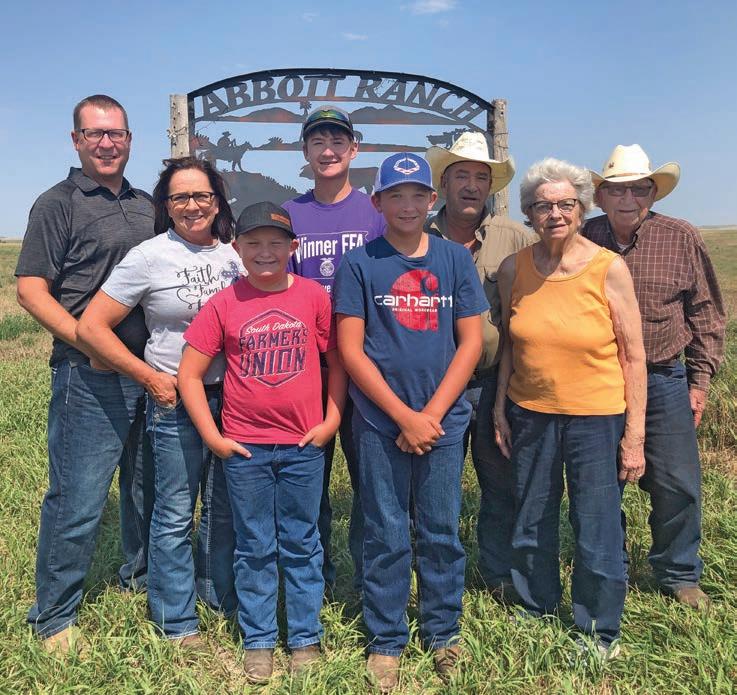
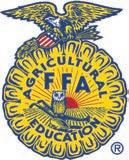
“It’s our way of letting consumers know that even though prices are up in the grocery store, profits for South Dakota’s family farmers and ranchers are not. The people who do the work to raise the food ingredients receive a small percentage of the price we all pay in the grocery store,” explained SDFU


State Fair 2022
Rancher Bill Abbott was just a kid when a neighbor hired him and his sister to ride pastures checking cattle and water tanks.
“He was a big operator and most of his hired men were drafted into World War II, so he was hard up for riders to check pastures. You talk to all guys my age, who were kids when World War II was on, and we all started working early because all the young men and women left for the war,” explained Bill, who at 89 is still actively involved in ranch work. Only, today, he works with his son, Bryan, and daughter, Kodi Blotsky, on the Todd County ranch where he and his wife, Kay, raised their six children: Kasey, Tracy, Bryan, Cleo (deceased), Lisa and Kodi.
Bill is the third generation to raise cattle near Hidden Timber, S.D. – a small ranching community 42 miles west of Winner. He said he

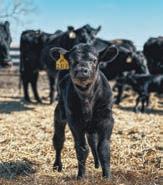 South Dakota Farmers Union has served South Dakota farm and ranch families for more than a century. Throughout the year, we share their stories in order to highlight the families who make up our state’s No. 1 industry and help feed the world. This month we highlight the Abbott family of Hidden Timber. Left to right: Chad and Kodi Blotsky; Chord, 10; Chaz, 17 (SDFU 2022 JAC) and Chase Blotsky, 14; Bryan Abbott, Kay and Bill Abbott. Share Lunch Feeds
Dallis Basel, Union Center rancher and District 5 Board Member.
South Dakota Farmers Union has served South Dakota farm and ranch families for more than a century. Throughout the year, we share their stories in order to highlight the families who make up our state’s No. 1 industry and help feed the world. This month we highlight the Abbott family of Hidden Timber. Left to right: Chad and Kodi Blotsky; Chord, 10; Chaz, 17 (SDFU 2022 JAC) and Chase Blotsky, 14; Bryan Abbott, Kay and Bill Abbott. Share Lunch Feeds
Dallis Basel, Union Center rancher and District 5 Board Member.
Abbott Family Continued on Page 2
Union Celebrates
A PUBLICATION OF SOUTH DAKOTA FARMERS UNION A Letter to the President PAGE 15 Leadership Seminar for JACs PAGE 7 Rapid City Packing Plant PAGE 12 Volume CVII, No. 5 Huron, SD AUGUST 2022 SERVING SOUTH DAKOTA’S FARM & RANCH FAMILIES SINCE 1915. Mentoring the Next Generation PAGE 17
Continued on Page 12
Karla Hofhenke,
Executive
Saturday, Sept. 3. Events begin at 11:30 a.m. For complete agenda turn to page 11. Free tickets for members, call Kelli at 605-352-6761 ext. 116 Farmers Union Day at the What a Farmer Earns: Farmers
Fairgoers for 35 Cents
realized this was where he wanted to make his life after he spent time away serving in the Army during the Korean War.
“I made a good soldier, but I didn’t like the Army. I had a lot of chances to stay in the Army, but I just said, ‘I don’t want any part of it.’”

Bill met Kay a few years after returning home to ranch with his dad, and namesake, William “Willy” Abbott. Kay grew up on a ranch a little more than three hours away, near Elm Springs.
Her parents, Milton “Slim” and Hallie Cordes, were good friends of Bill’s parents, Willy and Inez. When Bill returned to the ranch after the war, the couple visited, and Slim invited Bill to hunt on his Cheyenne River ranch.
“He made a comment about having plenty of deer and five daughters,” Bill recalled.
When the couple married, Kay’s dad and mom gave them 15 heifer stock cows. And together they grew their family and ranch.
“Kay knew how a ranch should run and she has always done a great job of keeping the family together,” Bill said.
Like his dad, Bryan decided to remain on the family ranch. Along with cattle, Bryan manages all the crop acres. “We feed nearly everything we raise,” Bryan explained.
All together Bill, Bryan and Kodi manage 2,000 acres of native range and cropland. The family owns some land and lease many acres from the Rosebud Tribe. “We would not be able to ranch without my dad’s

support,” explains Kodi, Kay and Bill’s youngest.
Kodi decided to make ranching her career after she and her husband, Chad, had their first son, Chaz. At the time, she was teaching high school computer classes in Todd County.
“I wanted my kids to grow up on the ranch,” Kodi said. “My dad always taught us how to work hard and gave us a love for the land and animals.”
The timing was right. Her dad and Bryan had recently lost a hired hand. “I asked Dad if they wouldn’t mind if I stayed home and helped out,” Kodi said.
Chaz, 17, has two younger brothers, Chase, 14, and Chord, 10. Kodi said that she and Chad made the right decision to return to the family’s ranch to raise their sons.
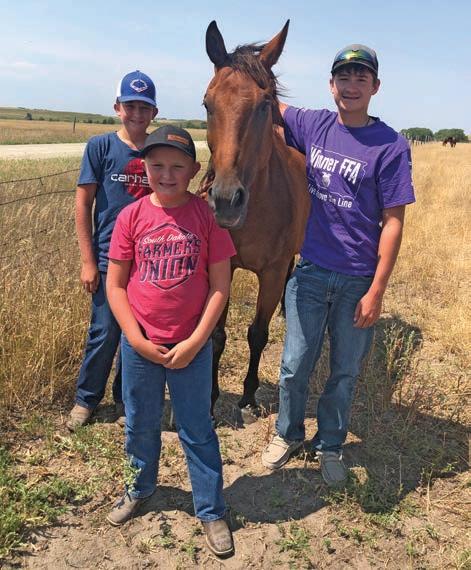
“It is a peaceful place to raise them, but also, my boys learn that it is not always fun. They learn the hardship of raising a calf or goat and even though we try our best to provide them shelter and food, but sometimes it doesn’t work out,” Kodi explained.
Getting through tough times is not foreign to the family. Bill’s grandpa, Frank Abbott, was lured west from Rock Rapids, Iowa, by the Homestead Act but his name was not drawn. After leasing some Tribal land, he bought his own place and built a successful ranch – only to lose everything in the 1920s when the banks failed.
“My dad said it broke Grandpa’s heart,” Bill recalled.
Willy got his start working for a cattle company, the Carr Ranch, and eventually built up a small herd and land of his own.
As Bill and Kay expanded the ranch, Kodi and Bryan said their parents created an environment for their children where they were encouraged to not only work hard, but to embrace their passions.
For Bryan, it was rodeo. “I always enjoyed working around the animals and being out in the country. I used to rodeo and thought that was pretty neat,” said Bryan, who was named 1980 champion bull rider at the State High School Rodeo Finals and he received the same title in 4-H Rodeo three years running. 800 21st St., Huron, SD 605.352.5792
Hidden Timber ranchers, Bryan and Bill Abbott.
Blotsky brothers enjoy riding horses on their Hidden Timber ranch. Left to right: Chase, 14, Chord, 10, and Chaz, 17.
DD Double D Western Wear & Tack
www.ddwesternhuron.com For the Cowboy In All of Us Farmers Union Members get 20% OFF* one item only! Present this coupon with your purchase *Excludes all boots, shoes, men’s jeans and tack Abbott Family Continued from Page 1 Union Farmer 2 August 2022 www.sdfu.org
“We used to practice on calves here,” Bryan explained. “Dad built a chute we could buck out of.”
“We would invite my grandparents to watch and have a rodeo night,” Kodi added.
Kodi enjoyed watching her older siblings rodeo, but it wasn’t for her. She found she enjoyed participating in other 4-H activities. She is happy her sons get to continue this tradition.
“Today people are so in tune with technology, but they are not able to communicate. I stress that my boys need to be able to communicate outside of technology and 4-H helps them with this because they all do 4-H demonstrations,” Kodi explained. “Public presentations help them gain confidence in themselves and they are able to stand up in front of people and be proud of themselves and teach others about something that they love.”
Chaz agreed with his mom, saying that in addition to the public speaking skills he’s gained through 4-H, the opportunity to work with his parents, uncle and grandparents on the ranch has helped him develop the skills he needs to succeed in other areas of life.
“Grandpa has always said, ‘Pay attention,’” Chaz explained. “So, I’ve learned to get the job done right the first time. As a kid, I used to take short cuts. Now that I am more mature, I take time and look at the details and do it right the first time.”
He added that his grandpa’s advice, to “pay attention,” comes to mind often.
“I take it to mean, ‘stay focused.’ In basketball for example, I need to stay focused on one play at a time. Same thing in school, focus on one class at a time. Same thing, here on the ranch, do one task at a
time and don’t skip steps,” Chaz added.
Today, Chaz is focused on getting a few of his meat goats ready for the Todd County Fair. Just a day away, the Todd County Fair is the first week of August. Chaz always brings a few of his tamest goats for fairgoers to enjoy as part of the petting zoo.
His brother, Chase, is going to enter a wooden sign he designed that features a flag and a cross. “At the fair I enjoy seeing all the things kids make and I also like to help at the petting zoo.”

And Chord is going to enter a horse show. “I have gotten into riding horses and – I am looking forward to that and look forward to the petting zoo,” said Chord, continuing a long-standing family tradition of horsemanship. More than a century ago, his great-grandfather trained horses for the Calvary.
Overall, Chaz said he sees his family’s involvement in the fair as a positive way to promote agriculture.
“The fair is a way to help the community and advocate for agriculture,” explained Chaz, who currently serves as a member of the South Dakota Farmers Union Junior
Advisory Council. The Junior Advisory Council is a teen leadership group who plan Farmers Union summer teen leadership camp. “It’s about carrying on traditions of Farmers Union and culture of leadership. I’m the next generation to do this and I’m excited to be able to help pass on these traditions to my brothers,” Chaz said.
Agriculture advocacy is a family tradition. Kodi, Grandma Kay and Great-Grandma Hallie have all been actively involved and held leadership roles in the South Dakota Cattlewomen’s Association.
“What I found is involvement really broadens my perspective,” Kodi said. “After being out here on the ranch, doing our own thing, raising cattle the way we do, involvement in Cattlewomen’s forces me to think about where the beef we raise goes and what consumers in California or New York think about the product we raise.”
A few years ago, Kodi, Kay and Bill joined with other South Dakota cattle producers in a South Dakota Cattlewomen’s booth where they provided beef jerky to bikers from across the nation during the Sturgis Rally.
“It was amazing because the majority of everyone we talked with loved beef (I only ran into about six vegetarians),” Kodi said. “I met many who had jobs related to the industry – working as a butcher or truck driver. The experience gave me hope that our nation does not look at agriculture as a negative.”
To view more photos of life on the Abbott ranch and read about other South Dakota farm and ranch families, visit www. sdfu.org and click on the South Dakota farm and ranch families link under the About Us tab.
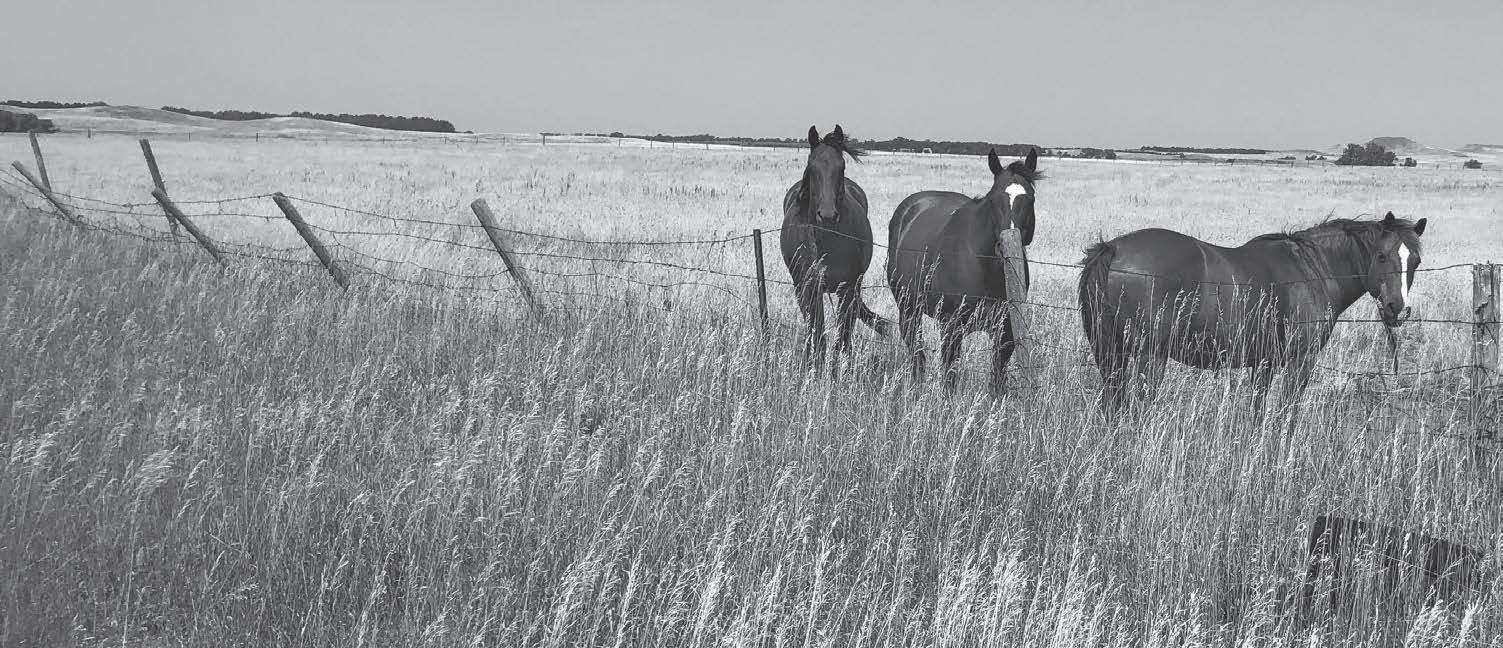 ■ By Lura Roti for SDFU
Along with public speaking, Chase Blotsky, 14, also crafted this wooden sign to enter in the fair.
■ By Lura Roti for SDFU
Along with public speaking, Chase Blotsky, 14, also crafted this wooden sign to enter in the fair.
“I wanted my kids to grow up on the ranch. My dad always taught us how to work hard and gave us a love for the land and animals.”
– Kodi Blotsky
Union Farmer www.sdfu.org August 2022 3
Members Support Family Farms Through Policy
Members guide South Dakota Farmers Union (SDFU) through grassroots policy development that supports family farms and ranches. It’s been this way since the beginning explains Doug Sombke, SDFU President and Conde farmer.
“For more than a century, our family farm and ranch focus has united us as members – not a specific commodity or issue,” Sombke said.
To ensure SDFU policy reflects the current needs of South Dakota producers, a committee of members representing all Farmers Union districts in the state meets annually to review the organization’s policy. After intensely reviewing the organization’s policy, Policy Committee members share their suggested updates and changes with all members who attend the Annual Policy Meeting.
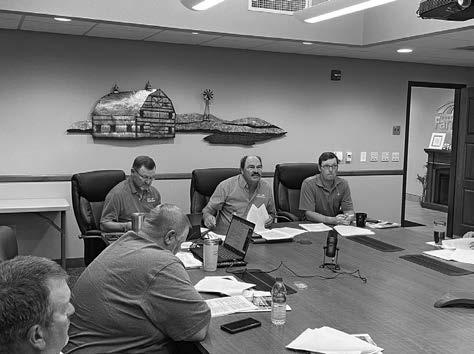

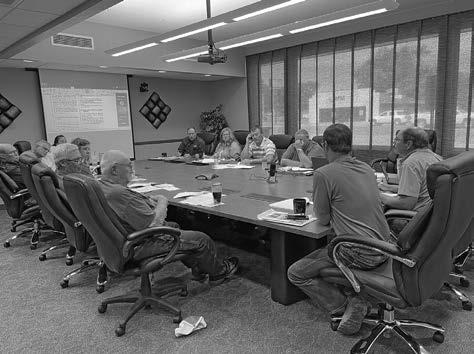
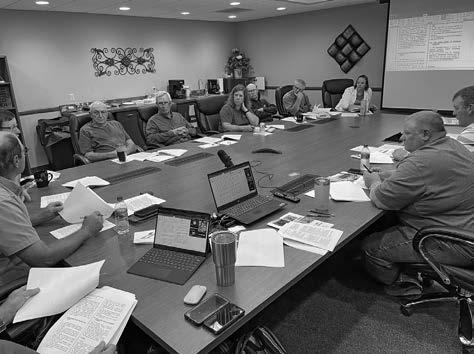
“Policy is the guts of this organization,” explained Hank Wonnenberg, a Dallas farmer, local banker and chair of the 2022 Policy Committee. “As a grassroots organization, the policy members develop becomes our playbook. It tells us where we stand on all issues.”
Throughout the year, Wonnenberg says he and his wife, Melissa, make note of local issues that impact them and other farmers. “This way when we get together with other members during policy meetings, we can present the information to see if
it is something that should be added to our policy book so that Farmers Union can address the issue,” Wonnenberg said.
The Wonnenbergs brought up concerns over a local water project that has the potential to displace crop and grazing land. After discussion, members decided the best course of action was to do more research and resume discussions on the topic during the policy meeting held during SDFU State Convention, Dec. 15 and 16.
“Nothing falls on deaf ears. I appreciate how as a Farmers Union member, our voice is heard,” Wonnenberg said. “Farmers Union has state and national lobbyists – so when you feel adamant about something, if other members agree, you know it will be followed up on.”
To address timely issues, during the 2022 Policy Meeting, members brought forward two Special Orders: short staffing of federal positions which support farmers and ranchers; and encouraging the EPA to enforce an existing clean air law that favors ethanol and other renewable fuels.
Discussion supporting the first Special Order, titled FSA/Conservation/Extension Support, focused on the impact short staffing has had on farmers and ranchers’ ability to apply for disaster relief programs or gain access to timely information.
“These are the departments that work hand-in-hand with so many farmers and
ranchers. They need to have the tools they need to help us,” said Gail Temple, a Clark farmer and District 3 Director.
The Special Order directs Farmers Union to lobby for pay increases for staff. “When there is a staffing shortage, it does not mean there is less work to do. As farmers and ranchers, we work closely with our local FSA, NRCS, Extension staff, so we know they are overwhelmed – morale is low,” Sombke said. “These experts are as important to many farmers and ranchers as their agronomist or nutritionist. To keep good people, salaries need to be competitive.”
The second special order also focused on the federal government. It was drafted in response to a recent Supreme Court ruling which determined in order for the Environmental Protection Agency (EPA) to enforce regulations, the regulations need to fall under existing Congressional law.
Special Order 1: FSA/Conservation/ Extension Support: Farmers Union calls on state and federal government officials and lawmakers to provide enhanced funding for FSA, NRCS, Extension and other local government offices to have sufficient staffing and equipment to run an effective and efficient office to meet producers’ needs in a timely manner.
Special Order 2: The recent Supreme Court decision that replaced the Chevron Deference Doctrine—which afforded EPA with extraordinary power in its regulatory discretion— with the “Major Questions Doctrine” requiring EPA to follow the express will of Congress opens the door to enforcement of section 202L of the Clean Air Act. Congress expects EPA to replace carcinogenic benzene-based BTEX used by petroleum refiners to enhance gasoline octane ratings with environmentally superior ethanol. If EPA does not act immediately, direct injection engines will dramatically increase the most dangerous toxic emissions.
• RESOLVED: SDFU and its supporters shall retain qualified legal counsel to compel EPA to do its job to protect public health and the environment by establishing a national E30 “Clean Octane” standard to achieve the greatest degree of reductions achievable in harmful BTEX emissions.
Union Farmer
4 August 2022 www.sdfu.org
The Supreme Court ruling focused on the Chevron Doctrine, ruling the document unconstitutional. The Chevron Doctrine contains several EPA regulations related to the environment.
“This special order does not say Farmers Union agrees or disagrees with regulations contained in the Chevron doctrine,” Sombke explained. “What it says is, based on this Supreme Court ruling, the EPA is now required to enforce the Daschle/Dole Clean Air Act of 1990, Section 202L. And Farmers Union advocates the EPA does just that.”
Section 202L of the 1990 Clean Air Act is
a law requiring that the cleanest and safest liquid fuel available for combustible engines needs to be used. Years of data show renewable fuels like the higher ethanol blend E30 and biodiesel are clean burning and safe.
Bottom line, Sombke explained this Supreme Court ruling has the potential to bolster South Dakota’s renewable fuels

industry and the family farmers who raise the crops to supply this industry.

“As a farmer we know to take advantage of opportunities when they present themselves. This is an opportunity for us to make hay – we don’t plan to pass it up,” Sombke said.
All policy updates and special orders discussed during the Policy Meeting will be voted on by members during the 2022 State Convention. Gail Temple said she is eager for policy discussions to resume.
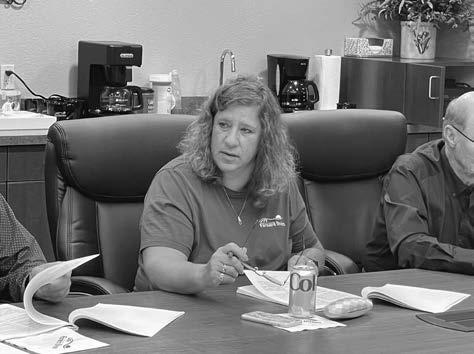
“Policy is who we are and what we stand for as an organization,” Temple said. “I enjoy listening to everyone’s input.” ■

“Policy is who we are and what we stand for as an organization.”
– Gail Temple
Union Farmer www.sdfu.org August 2022 5
Swade Reis turns clucks into bucks
Ahen named Delilah started Swade Reis,17, on his successful egg business.
“What a testament this is to the character and leadership skills of these rural South Dakota youth,” said Doug Sombke, South Dakota Farmers Union President and fourth-generation Conde crop and cattle farmer.
“My great-grandmother Peggy Reis gave me my first chicken and a dozen eggs to hatch when I was five,” he says. “Now I have 150 big chickens, 50 chicks and am selling eggs to family, friends and two grocery stores.”
To keep up with the demand for Swade’s Eggs, he ordered 60 more chicks to be delivered at the end of May. He runs his egg business from his family’s operation near Reliance, S.D.
“I pick about eight dozen eggs a day. It really fluctuates with the temperature. If I’m gone, my family will pitch in with the feeding and picking.”
As a busy junior in high school, he enjoys wrestling, band and rodeo. But Swade is also dedicated to his business and the ranch. The family lives 30 minutes from school, so his parents, Heidi and Shawn Reis, feed and water the chickens in the morning.
Each night, he picks the eggs and takes them to the cooler in the basement where he has his equipment. Every two days, he washes each egg by hand, candles the eggs to make sure there are no cracks or blood spots and packages them. He stamps each carton with his logo and other identifying

information plus the “best use date,” of a month away.
As this is a business, he has a license and learned to order supplies, such as 1,000 egg cartons at a time. On his way to school in Chamberlain, he drops off the invoices along with the eggs, which he sets in the refrigerators at the stores.
Five years ago, the chickens were in two coops. He’s insulated and remodeled an old grain bin into his chick brooder. “I initially let my chickens range free. Because of predators, I had to be careful once I got more birds. Now I fence them into an enclosure and let them out when I’m home so they can eat bugs and roam.”
Classes at school in business and economics taught him about setting up invoices and calling store managers to negotiate prices. His mother, Heidi, is always there to offer a helping hand on the bookwork and the check-depositing part. Swade learns “the chicken part” from looking up information, picking tips up from grandparents, and “always paying attention to anything to do with chickens, really.”
Last year, he’d planned to submit the paperwork for his business for his FFA supervised agricultural experience, but he didn’t get that done. “I have the numbers but will make it a priority for next year. I’ll have more data then.”
Disease potential on the horizon
Recent news about the spread of the avian influenza, which travels through the air has him concerned. “When I order chicks, I isolate them from the rest of the birds. I’ve learned a lot from my great-grandmother and my grandpa about ways to protect the birds. Hopefully, we’re far enough away from others that it won’t affect my flock.”
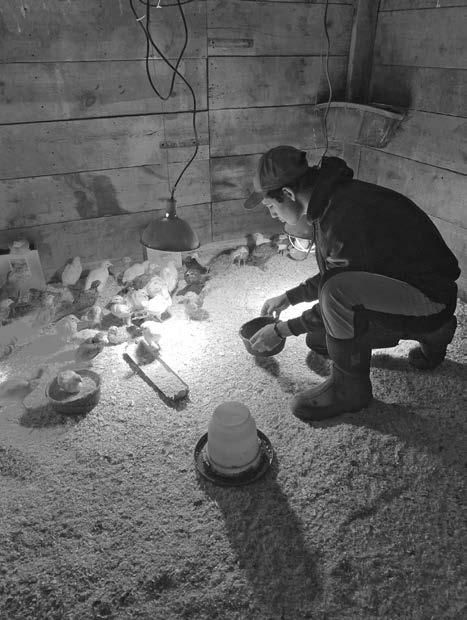
The family has dealt with disease issues before. “A few years ago, we lost 50 of 150 chicks because they got coccidiosis. We think they got it from Mom’s goats. Now we medicate for it to keep it under control,” Swade says.
Chickens live for about 10 years. “If you keep them healthy, that might be 15 years. They lay the maximum for their first two or three years and then production slowly decreases. Some keep laying for eight years.”
In his flock, general laying hens include White Leghorns, Barred Rocks, Ameraucanas, Rhode Island Reds, Buff Orpingtons and Australorps. Chicks can cost from $2 to $4.50. The price for exotics can
be outrageous. Meat chickens are cheaper, about $1 to $3.
Swade recently ordered about 60 Australorps. “I’ve found they are the most hardy and productive. They seem to do better for me than the White Leghorns, which are in a lot of the high-production operations.”
Certain high production breeds can lay eggs like crazy, some reaching 360 eggs per year, but he said that ages them a lot faster. “I have more chickens that lay brown eggs but have a close amount that lay white eggs. I have about 30 Ameraucanas that lay blue and green eggs, I mix them together when I package them for the store.”
Originally Swade sold eggs for $2 a dozen, and the store sold them for $2.50. Now with the shortage, “I sell them for $3 and then the stores sell them for $4. It’s crazy, especially when some places in Sioux Falls are selling them for $6.50.”
The money he’s earning will help pay for college. “I also have cattle and work with my dad on the ranch. I pay for my gas money and my vehicle. Most of my profit goes in my checking and savings account.”
For fun, Swade has some exotic chickens, including some with afros, some Guinea hens, six ducks and two geese. The mystic onyx chickens are all black and even their meat is all black. “The geese are protective of the chickens. Dogs won’t attack the chickens as the goose will grab the dogs by the tail.”
Eggs for the community
Pat Kerwin of Buche Foods in Oacoma commented on Swade’s dedication and initiative. The business is in the former Sunshine Foods building at Al’s Oasis.
Swade Reis
Swade Reis is a Farmers Union member from Reliance.
Union Farmer 6 August 2022 www.sdfu.org
Continued on Page 19
Strengthening Strengths – Junior Advisers Prepare for 2023 Camp Season Through Personal Development
Camp is for campers. This focus motivated a leadership development training designed for the recently selected Junior Advisory Council, explained John Beranek, Farmers Union Leadership consultant and owner of Intersections Consulting.
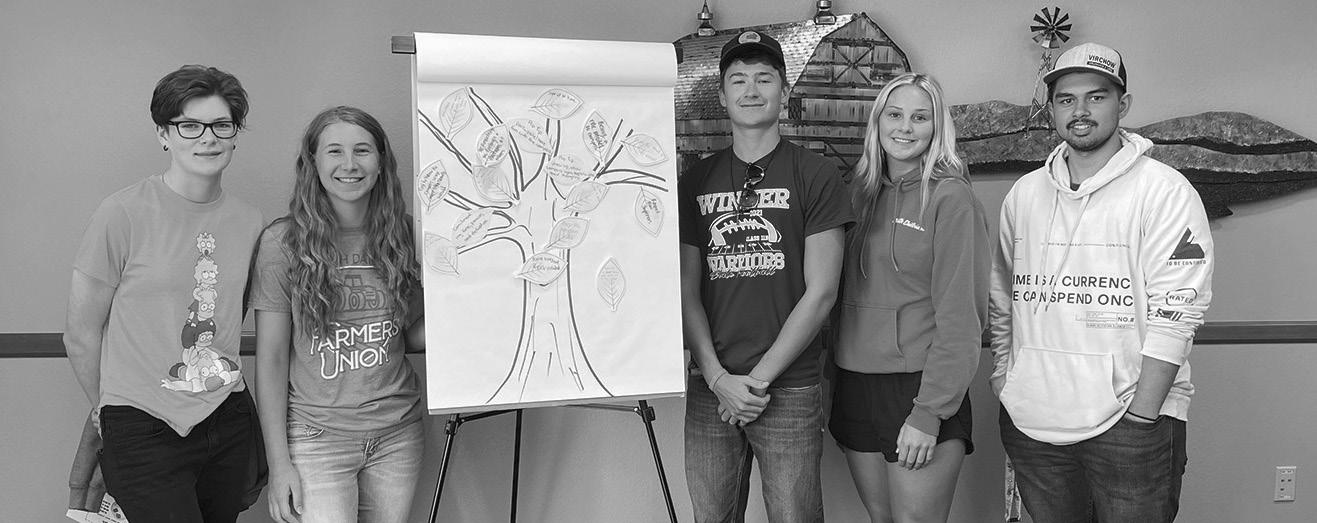
“Camp is no longer for you – it is for campers,” Beranek told the teen leaders. “As leaders you have to switch the mindset around this.”
What Beranek said made sense to Aeriel Eitreim.
“Last year as a camper all the responsibility was on the Junior Advisory Council. I was able to be a kid and run around and not worry about anything. This year, I need to take on responsibility and make sure the campers are engaged and involved,” explained the Sioux Falls Roosevelt High School senior.
Eitreim serves on the Junior Advisory Council with Ashley Hanson, Britton; Chaz Blotsky, Mission; Jayda Walton, Mitchell; and Garrett Kruger, De Smet.
Thinking about the responsibility of not only planning the 2023 Farmers Union Leadership Camp but the role she now has serving as a member of the leadership team of counselors, Eitreim said she is happy she’s not in this alone.
“At first, I felt a little stressed out by the idea, but then I realized, I am not doing this
alone. By working together, we can compile thoughts and ideas to make camp just that much better than last year,” Eitreim said.
To prepare the teens for this responsibility, Beranek had each team member take a personality test. “As leaders, it is your responsibility to understand the difference in personalities and types of behaviors those personalities will show up with and what campers’ needs and wants are from their leaders. Learning to anticipate rather than react to behaviors keeps leaders from being triggered,” Beranek said. “If you can predict how someone will behave, you ought to be able to respond differently.”
This opportunity to learn more about himself was something Chaz Blotsky appreciated.
“Learning about myself helps me learn about other people and how I treat myself and others,” Blotsky said. “I will definitely use what I learned to help campers get involved during camp.”
Beranek explained to the teen leaders during the leadership training that there are four basic personality types, and they have the potential for conflict. “It is human nature. So, if we are truly going to be leaders, we need to be masterful about meeting the needs of all personality types. If you are rooted and grounded in that understanding, you have better chance of not being triggered and also have the ability
to understand how they learn.”
Blotsky said what he learned from Beranek about the different ways different personality types interact will help the team as they work together to plan camp and work with campers during camp.
“What we learned about communication is important because we need to be able to work together since we want to make camp a better overall experience for campers,” Blotsky said. “What I learned will affect how I will behave as a camp counselor and how I communicate with campers.”
Blotsky said he plans to implement what he learned during this seminar in other areas of his life. Growing up on a ranch in rural Todd County, he holds leadership roles outside of the Junior Advisory Council. He has two younger brothers and is captain of the varsity basketball, track and cross country teams at Winner High School.
Beranek said the leadership training he guided the Junior Advisory Council through is the same training he provides to board members or executives. “I don’t dumb this down for kids. These are the same types of things I teach adult leaders,” Beranek explained. “I have a firm belief when you help build skills around leadership development, you have the largest ripple possible. This is what Farmers Union is working to do.”
■ By Lura Roti for SDFU
Junior Advisory Council members: Ashley Hanson, Britton; Aeriel Eitreim, Sioux Falls; Chaz Blotsky, Hidden Timber; Jayda Walton, Mitchell; and Garrett Kruger, De Smet.
www.sdfu.org August 2022 7 Union Farmer
Union Farmer
2022 Rural Dakota Pride Honorees
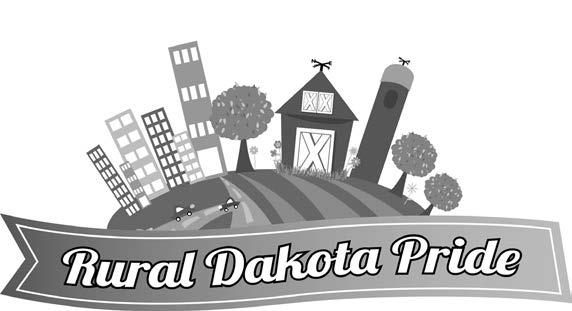
Each year, SDFU recognizes individuals who give back to their communities with the Rural Dakota Pride Award. To meet the 2022 honorees, attend the Rural Dakota Pride Ceremony held at 12:45 p.m., Sept. 3, during Farmers Union Day at the South Dakota State Fair on the Freedom Stage. Profiles by Lura Roti for SDFU
JUDY ROEMICH, Piedmont
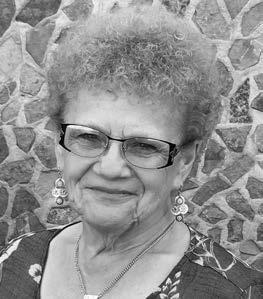
Christmas holds a special place in Judy Roemich’s heart. The Piedmont resident goes out of her way to make sure all families in Piedmont receive gifts on this special day. Since the early ’90s, she has organized Giving Trees throughout the community, collecting about 700 donated gifts for about 70 Piedmont and Black Hawk families each year.
“Let’s face it, even as adults, we all like presents,” Roemich said. “I just can’t bare thinking that any kids will not receive Christmas gifts.”
The Giving Trees project was started by a member of her sewing club, and when this member was in her 90s, Roemich offered to help her out. The member said she didn’t want help, she wanted Roemich to take the holiday giving tradition over.
So, for nearly 40 years, Roemich collects names and addresses of families who need gifts from the area food pantry which she helped organize more than 30 years ago. In addition to donated gifts from Giving Trees, Roemich and the other members of the Happy Ten Sewing Circle also give handmade gifts.
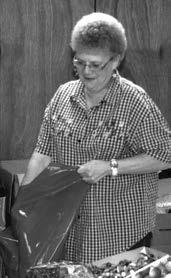
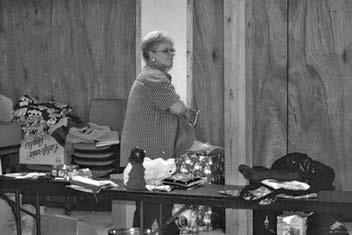
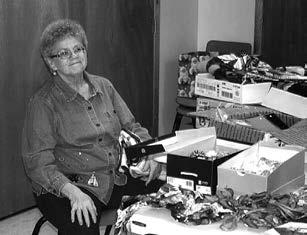
Once the gifts are made and collected, Roemich and the sewing club members set up shop in Our Lady of the Black Hills Catholic Church, spending about a week wrapping gifts. Then, local firefighters load up their fire trucks and deliver gifts to families.

“It just warms my heart when we deliver gifts to families and I see their children’s eyes light up,” Roemich said. ■
MARY JACOBS, Huron
When Mary Jacobs saw 7-year-old Alex’s face light up after hearing his wish was granted – he was going on a Disney cruise – she knew she’d be a Make-A-Wish South Dakota volunteer for life.
“When a Wish kid smiles at you, because their wish is granted, you’re tied to them forever,” explained Jacobs, who has served as a Make-AWish volunteer since 2000.
Make-A-Wish is a non-profit that works to grant wishes to children with critical illnesses. Jacobs’ volunteer title is “Wish Granter.” In this role, she travels to rural communities throughout South Dakota and interviews youth who have been referred for a wish.
She makes sure the wish is 100 percent the child’s idea and then makes a recommendation to the Make-A-Wish staff.
Working with other volunteers and the Make-A-Wish South Dakota team, Jacobs has helped grant more than 50 wishes over the last 22 years. Jacobs says through the process she has developed lasting friendships with other Wish volunteers as well as Wish recipients and their families.


And as a Wish Granter, she gets to see quite a few smiles.
“A wish gives a kid the chance to be a kid again,” she said. “They can forget about the doctors, forget about the lab coats, and do something they want to do more than anything.” ■
“I just can’t bare thinking that any kids will not receive Christmas gifts.”
– Judy Roemich
“When a Wish kid smiles at you, because their wish is granted, you’re tied to them forever.”
– Mary Jacobs
Mary Jacobs with Kayden.
8 August 2022 www.sdfu.org
DALE SWENSON, Woonsocket
In 1976, Dale Swenson received notice about the upcoming Woonsocket Annual Alumni Banquet. But for some reason he didn’t attend.
“I heard after the banquet, that during the annual meeting I was elected to serve as president for 1977, my 10th year out of school. The president is responsible for organizing a banquet to feed about 300. That’s when I learned, I should probably show up for meetings,” Dale said.
DAN & CORINNE OVERWEG, Kimball
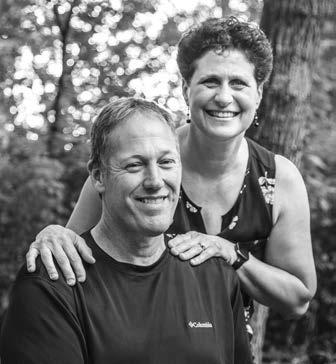 – Dale Swenson
– Dale Swenson
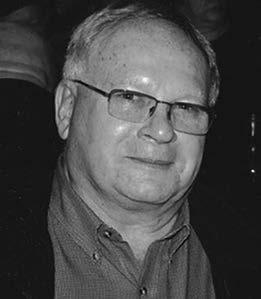
For nearly 40 years, Dale has done much more than attend meetings. He has worked with other community volunteers to ensure time-honored traditions, like the community Water Festival, Christmas Nativity scene on Woonsocket’s Lake Prior Island, and needed services, like Meals on Wheels, continue to thrive.
It occurred to Dale that, “Someone needs to do these things, and I think, why not me,” he said.
He explains that his commitment to community stems from family roots. His family has been active members of the Woonsocket community since the 1880s.
In 1984, Dale saw a meeting announcement in the local paper. It asked for volunteers to help plan the annual Water Festival. Previously, the planning committee had dissolved, and local citizens worried that the more than a century-old community tradition would end.
“As a kid, the Water Festival brought people from all over the county – it was something our community needed,” Dale says of the Fourth of July Water Festival celebrating Woonsocket’s beautiful Lake Prior with fireworks, a parade and outdoor games for all ages.
Part of a hardworking team of volunteers, Dale saw a need to bring back water-related activities. “It was the Water Festival, but there wasn’t much going on around the lake anymore, so I suggested canoe races.”

Canoe races inspired water tank races, water golf and other fun lake activities. Decades later, thanks to efforts of volunteers like Dale, the event continues to thrive. ■
When Dan and Corinne Overweg were expecting their youngest, Corinne was put on five weeks of bedrest. The couple had two young children and a family business to run. They felt overwhelmed.
Their community of Kimball was there for them.
“Community members began coming over and putting food in our freezer and fridge. A couple ladies even cleaned my house,” Corinne recalled. “In this community, we help each other out.”
Twenty-five years later, their youngest son, Hayden, and their oldest son, Gavin, are working with their parents in their full-service automotive, truck repair and motorsports business, Overweg Repair. Overweg Repair is among the largest employers in Kimball. Dan and Corinne continue the tradition of helping out.
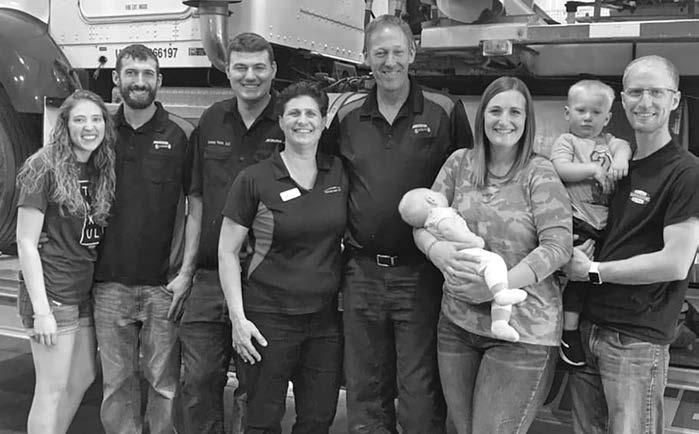
Whether it’s serving as Christian education leaders for St. Margaret’s Catholic Church or serving as a volunteer firefighter or helping raise funds for a community scholarship fund, Main Street Park, new swimming pool or on the committee to build a new medical facility, the Kimball community knows they can count on the Overwegs.
“It’s just who we are,” explained Dan, who grew up in Kimball. “And it’s about family.”
All of Dan’s immediate and extended family live within 30 miles of Kimball. Today, he and Corinne’s grown children and grandchildren also live there. Even though she didn’t grow up in Kimball, when Dan and Corinne married, she knew Kimball was home.
“I think this small town has been the best place to raise our kids,” Corinne said. “Seeing this community grow and thrive and be the place where young families want to live – this is why we give back.” ■
“Someone needs to do these things, and I think, why not me.”
In this community, we help each other out.”
– Corinne Overweg
Left to Right: Jennifer & Gavin Overweg, Hayden Overweg, Corinne & Dan Overweg, Alexa & Corey Kapp with Ivy (Alexa is holding), Levi (Corey is holding) Kapp. Not in picture is the newest grandson (Jen and Gavin’s) Lincoln Overweg.
Dale Swenson beside Lake Prior.
www.sdfu.org August 2022 9 Union Farmer
Union Farmer
Kolousek Family Shares How Soil Health Extends Grazing Season and Keeps Soil from Blowing
If you take care of the soil, it will take care of you, explained fourth-generation Wessington Springs farmer Dick Kolousek.
“The more we can do to keep the soil productive, the more the soil will produce – even in dry years,” Dick said during a Soil Health Tour held on his family farm and hosted by South Dakota Farmers Union and South Dakota Soil Health Coalition.
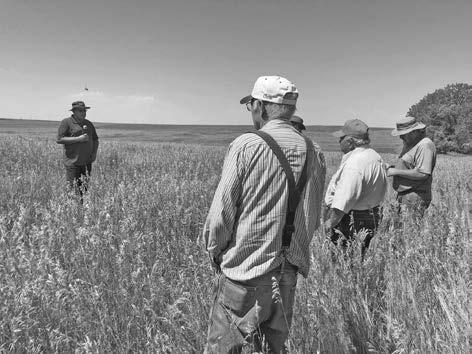

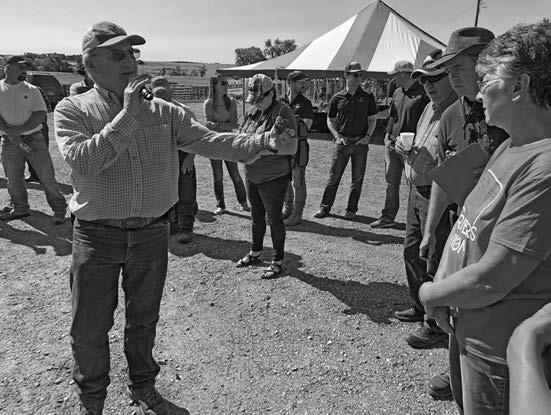
Dick raises crops and cattle together with his son, Scott. Scott said although soil health has always been something he and Dick considered – the farm has been notill for more than 20 years – the men really began focusing on soil building practices about 15 years ago. That’s when they got serious and began:

• Introducing cover crops into their corn and small grain rotation.
• Revitalizing dung beetle populations by doing away with pour-on fly insecticide funded partially through Natural Resources Conservation Service (NRCS) Conservation Stewardship Programs.
• Intensifying grazing rotations by installing more fencing and water tanks funded partially through Environmental Quality Incentive
Program.
Scott said the results can be seen throughout their farm – starting with an increase in organic matter. The organic matter is more than 6 percent in fields across the farm. “Increased organic matter means we do not need to apply as much fertilizer on our crop acres – and that saves us money.”
Another cost savings is reduced feed costs. “When I was a kid, we started feeding hay around Thanksgiving,” Scott said. “This last winter our cows were out grazing until the first of February – now granted there wasn’t any snow on the ground. But even with snow on the ground, the cows will dig under the snow to get to grass.”
The Kolouseks typically plant a diverse cover crop mix into wheat stubble mid-July. And it’s ready and waiting when they turn their cows out on it after weaning around the first part of November. “Compared to grazing on cornstalks, the cows really thrive on cover crops,” Scott said.
During the tour, attendees were bused to pastures and had the opportunity to walk through crop fields so they could see the grazing and cover crop rotations firsthand.
Providing an opportunity for farmers to see for themselves how soil health practices
work, is the reason South Dakota Soil Health Coalition (SDSHC) asked to host a tour on the Kolouseks’ farm.
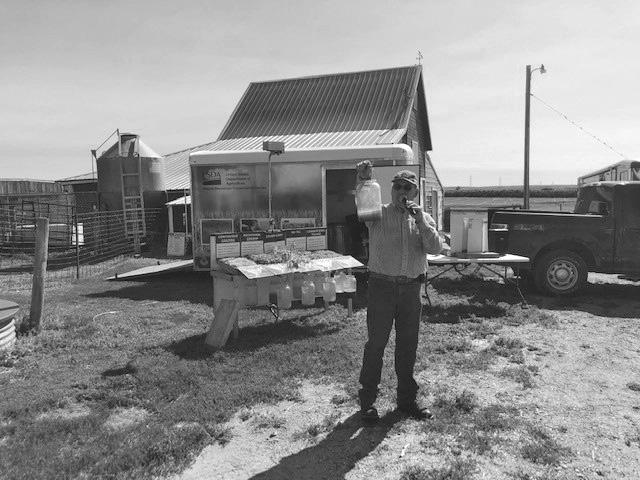
“Farmers and ranchers are key to improving soil health in South Dakota. Field tours give them the opportunity to see firsthand the successes and failures of others and take back something to make their operation more sustainable,” explained Cindy Zenk, SDSHC Coordinator.
When Zenk called the Kolouseks to ask if SDSHC could host a tour on their land, Scott said the timing was perfect.
“It was April and the wind was blowing the dirt around – but on our fields, no soil moved. I want to stress to keep soil from blowing it needs to be covered. Cover crops help do that,” Scott explained.
The tour began with a rainfall simulator demonstration to help explain the science behind cover crops’ ability to hold soil as well as moisture.
“A raindrop hits the ground at about 15 to 20 miles per hour,” explained Austin Carlson, SDSHC soil health technician. “When you have a growing cover crop covering the soil, the plants break the impact of these raindrops preventing them from displacing soil particles. Also, the more times we have something actively growing
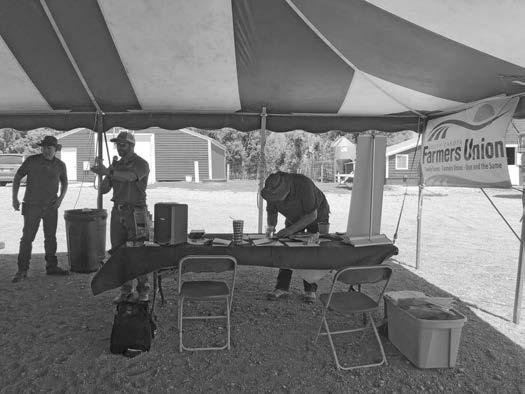
10 August 2022 www.sdfu.org
in the soil, the biology of the soil helps bind soil particles together, basically weather proofing it.”
Carlson added that in a healthy grazing system, healthy, strong root systems aid in water infiltration.
Practices to build a healthy grazing system were the focus of many tour discussions. Three years after Rodney Huisman replaced continuous grazing with
rotational grazing of his cattle, the NRCS conservationist for Jerauld County saw an increase of 1,000 pounds of grass per acre.
“NRCS standard is take half, leave half. This way the plant leaf can act like a solar panel to take in energy from the sun through photosynthesis and regenerate itself,” Huisman said. “It’s not about the days of grazing. It’s about the days of rest. Healthy plants equal healthy soil.”
Union Farmer
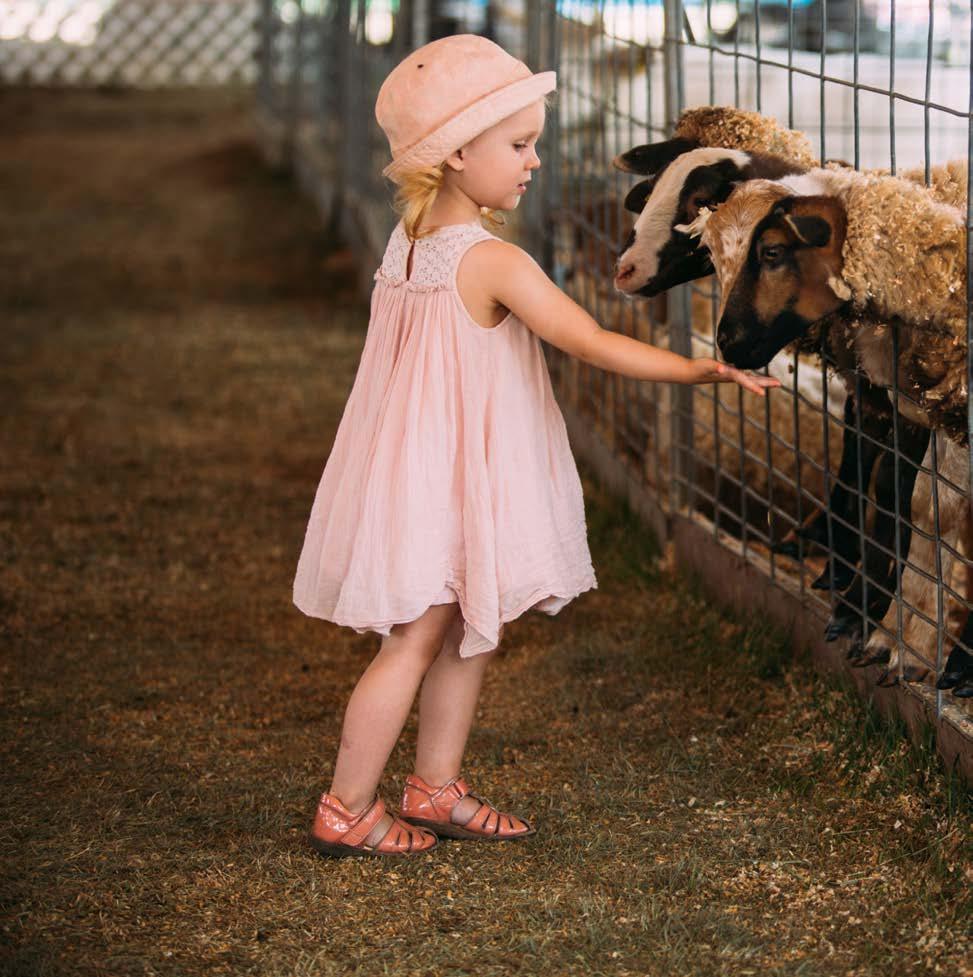
Forestburg cattle producer, Joseph Davis agrees. He and his dad, Jack, also implement rotational grazing practices and have seen the benefits. Davis said he attended the soil health tour for the opportunity to gain additional tips to help him fine-tune their existing practices.
Kolousek Family
Saturday, September 3 DAY Join us for

at the 2022 SD STATE FAIR
11:30 am FARMERS UNION TENT
TENT NEAR FREEDOM STAGE
Farmers Share Luncheon includes sandwich, chips & drink. We are selling this meal for the same price the Farmer makes off of it, 35¢!
12:45 pm FREEDOM STAGE
Rural Dakota Pride Award Presentation
1:00 pm FREEDOM STAGE
Farmers Union will host a panel on Strengthening South Dakota’s Beef Industry
2:00 pm FARM SAFETY
QUIZ BOWL
FREEDOM STAGE
Test your farm safety by watching the annual Team Up For Farm Safety Quiz Bowl Finals!
Check Out our Booth in the Expo Building and the Farm Safety Trailer on 3rd Street, all week long!
Show your Farmers Union pride by wearing your SDFU apparel (shirt, cap, etc.) for a chance to win CASH PRIZES!
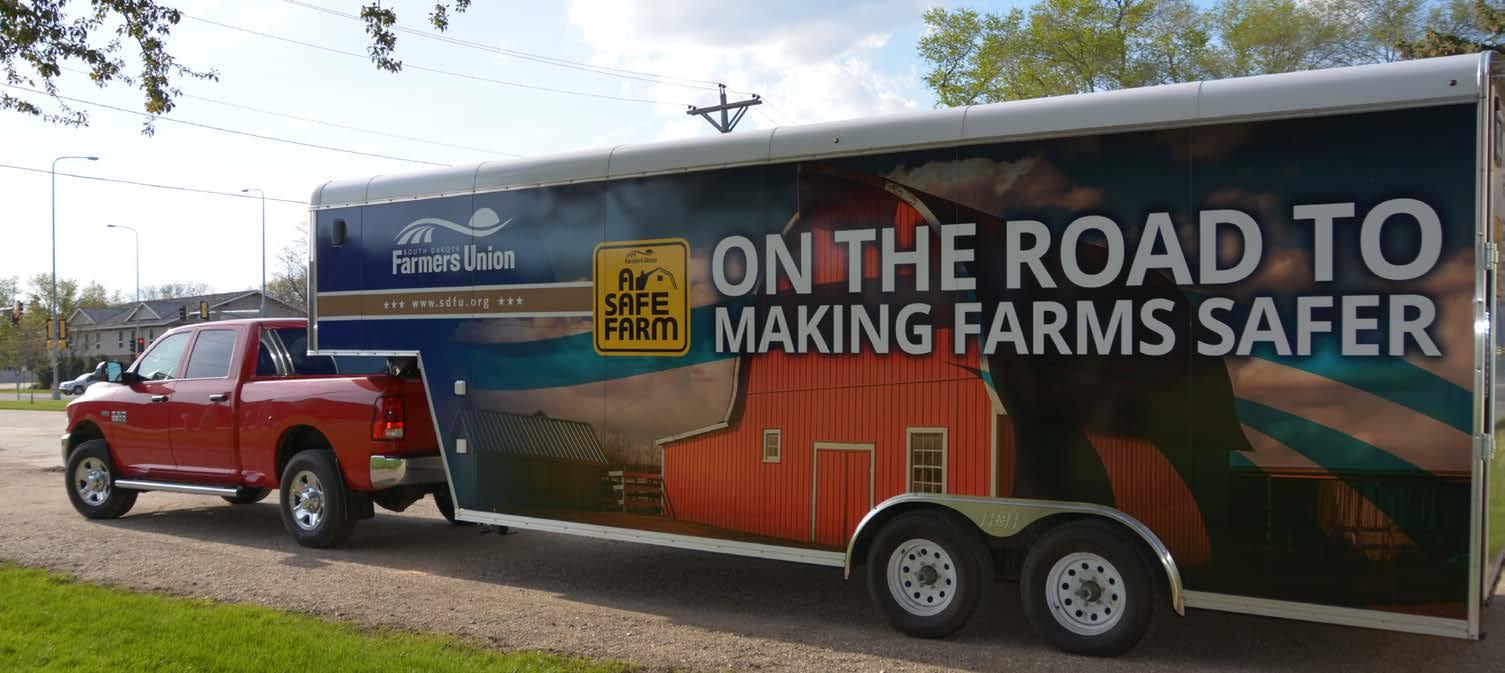
www.sdfu.org August 2022 11
Continued on Page 14
Union Farmer
Rapid City packing plant: New facility expected to be the nation’s largest
By Carrie Stadheim, Editor, Originally published in the Tri-State Livestock News June 10, 2022
WWith plans to finance a brand new Rapid City-based beef and bison processing facility that would slaughter more than any single beef plant currently in operation, Kingsbury and Associates and Sirius Realty of Rapid City and Greenville, S.C., have made waves across cattle country in recent weeks.
Megan Kingsbury, president and managing partner of the debt/ equity capital firm, said her goal is for the plant to process 8,000 head per day when at peak operation. This is to include bison, cull cows and bulls, as well as finished cattle. The plant will be under a recently announced “Western Legacy

Development Corporation.”
Kingsbury says competition in the processing industry has been greatly reduced over the years “because what we perceive to be the big four, have controlled this from perhaps backroom negotiating at times,” she said. “What this does is it allows transparency and competition,” she said of the planned new plant. “We want to be sure we are buying out of our sale barns locally. Our entire procurement dimension is going to be massive. We are that second bidder in the barn, and our hope is to see an increase in sales in the barns because they know we will have a second bidder.”
In addition to purchasing cattle through the sale barn, Kingsbury expects to have to procure some cattle via AMAs or contractual marketing agreements, but she hopes to keep that need to a minimum.
Kingsbury says she is “very aware” of ranchers’ concerns with imported beef being sold under the “USDA” label which can mislead consumers into thinking it is U.S. beef. “We want to be sure we are putting America first by using only American beef products – born, raised, finished, produced here in the United States. It’s important to me since this is a personal project and as a fifth generation producer here in South Dakota that it is all that.”
“Part of our research and development is developing a brand specific to South Dakota, to American beef and to feeding America,” she said.
“There will be a brand created and it will be shelf ready when it leaves the plant,” she said. She said information about the aging
Director.
The annual Farmers Share Lunch is held at 11:30 a.m. during Farmers Union Day at the State Fair Saturday, Sept. 3. The meal will be served in the Farmers Union Tent across from the Freedom Stage at the South Dakota State Fair. South Dakota Farmers Union is a premiere sponsor of the South Dakota State Fair.
“This event draws attention to the fact that farmers and ranchers are not doing as well as it may seem from grocery store prices,” said Union Center rancher Dallis Basel. “We look forward to this lunch each year because we like to share a meal and the story of our ranch with consumers.”
The fact is, even though they raise the food ingredients, family farmers and ranchers pay the same prices at the grocery store as families who don’t work in production agriculture. And like most American families, farm and ranch profits are not following the spike in household expenses like groceries.
“We go grocery shopping just like everyone else,” said Basel, who raises sheep and cattle together with his wife, Tammy. “Even though prices are up in the grocery store, we do not earn much more than breakeven on cattle and right now, the sheep markets have bottomed out, so we are going backward when we sell market lambs.”
A lifelong Farmers Union member, Basel said he appreciates the efforts that go into the annual Farmers Share Lunch because feeding more than 1,000 fairgoers helps connect consumers to the truth.
“Big conglomerate food processors and the packers are making exorbitant profits –not family farmers and ranchers,” explained Basel, who serves on the state board for SDFU.
Strengthening South Dakota’s Beef Industry
Working to hold meat packers and food processors accountable and transparent is a focus of Farmers Union policy. During Farmers Union Day at the State Fair, the state’s largest agriculture organization will host a panel discussion focused on strengthening South Dakota’s Beef Industry. Panelists include Doug Sombke, SDFU President; Megan R. Kingsbury, Kingsbury & Associates - President/CEO and founder of the proposed Rapid City beef and bison packing plant; Dale Bednarek, Farmers Union Industries and James Halverson, Executive Director South Dakota Stockgrowers.Once complete, the facility will be the world’s largest – a $1.1 billion state-of-the-art beef and bison processing plant with capacity to harvest 8,000-head per day.
“This plant will provide needed
competition to the Big Four packers,” said Doug Sombke, President of SDFU and a fourth-generation Conde crop and cattle farmer.
The panel discussion will begin at 1 p.m. on the Freedom Stage and is open to all. Right before the panel discussion, SDFU will recognize rural volunteers with the Rural Dakota Pride Award at 12:45 p.m. 2022 Rural Dakota Pride honorees are Dan & Corinne Overweg, Kimball; Dale Swenson, Woonsocket; Judy Roemich, Piedmont and Mary Jacobs, Huron.
In addition to the Rural Dakota Pride presentation and panel discussion, SDFU will host a Farm Safety Quiz Bowl championship at 2 p.m. featuring teams from four FFA chapters that qualified during the 2022 State FFA Convention: Canton, Gettysburg, Kimball and Lennox Sundstrom.
Making wishes come true
All proceeds and donations collected during the Farmers Share Lunch will be given to Make-A-Wish South Dakota.
“Children are our future. Supporting children with critical illnesses and their families is one more way to make an impact during Farmers Union Day at the State Fair,” Hofhenke said.
To learn more about Farmers Union Day at the State Fair, visit www.sdfu.org ■ By Lura Roti for SDFU Fair 2022 Continued from Page 1
Kodi Retzer
Megan Kingsbury
Packing Plant
Kingsbury is a forum panelist Sept. 3 at 1 p.m. on the Freedom Stage during Farmers Union Day at the State Fair.
12 August 2022 www.sdfu.org
State
Continued on Page 16
2022 County Camps
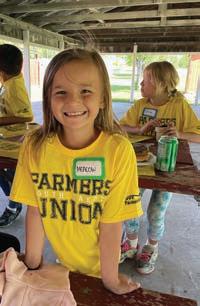

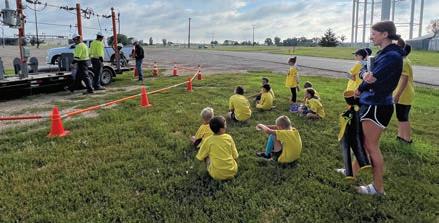
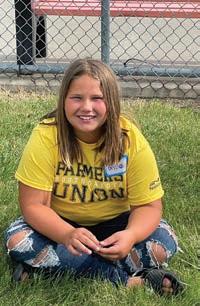
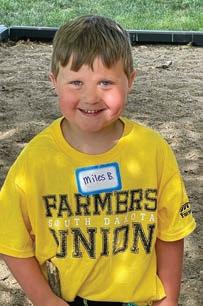

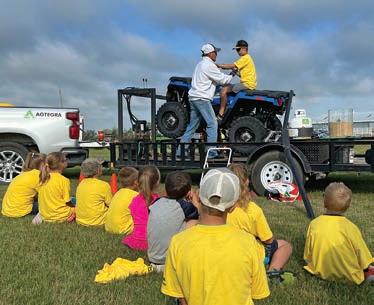
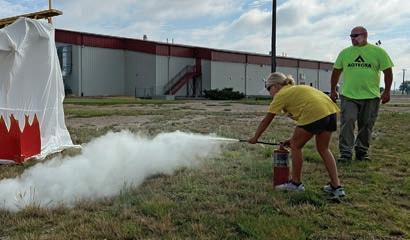
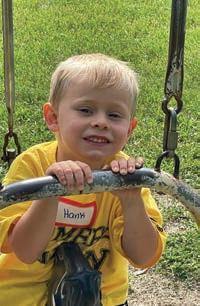
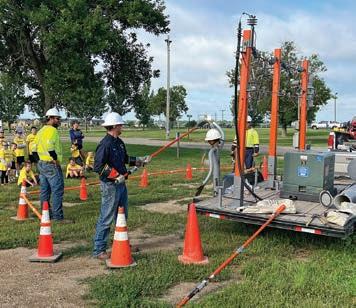


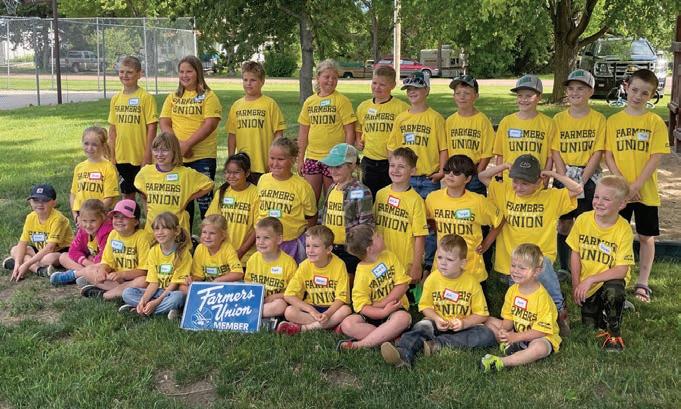
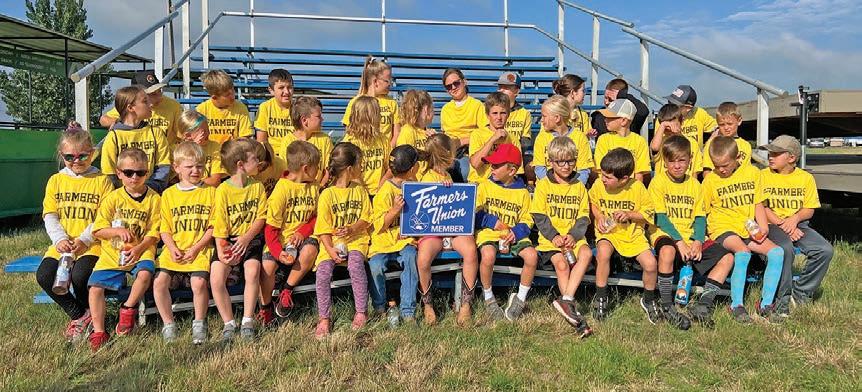
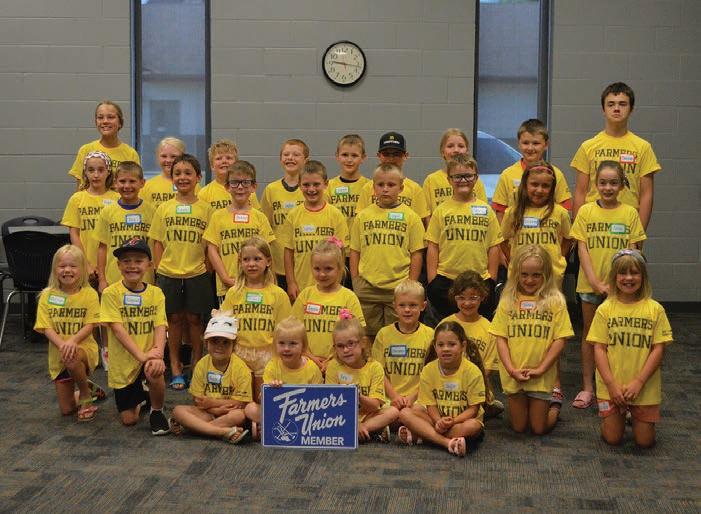
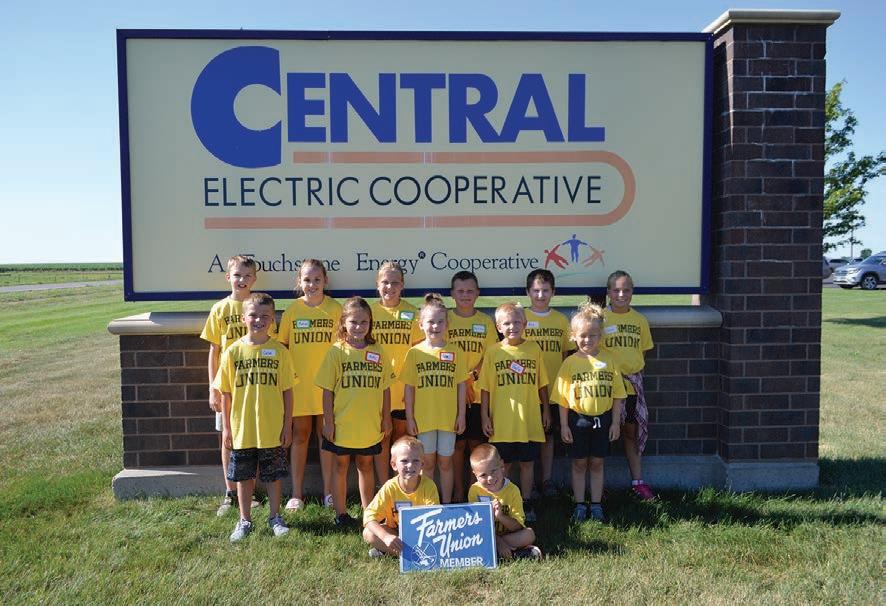

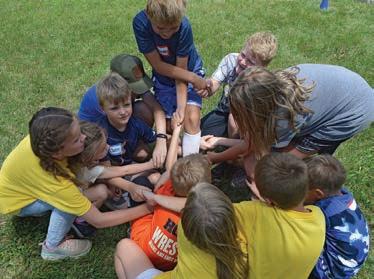
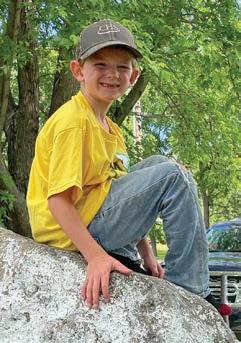

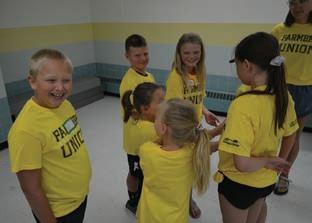
www.sdfu.org August 2022 13 Union Farmer
Union Farmer
Three South Dakota Youth Elected to National Farmers Union Leadership Team
South Dakotans Garrett Kruger, Lake Preston; Levi Nightingale, White Lake; and Tyler Hanson, Britton, were elected to serve on the National Farmers Union (NFU) National Youth Advisory Council (NYAC) during the organization’s 84th AllStates Leadership Retreat held on the shores of Lake Wissota near Chippewa Falls, Wis.
“What a testament this is to the character and leadership skills of these rural South Dakota youth,” said Doug Sombke, South Dakota Farmers Union President and fourth-generation Conde crop and cattle farmer.
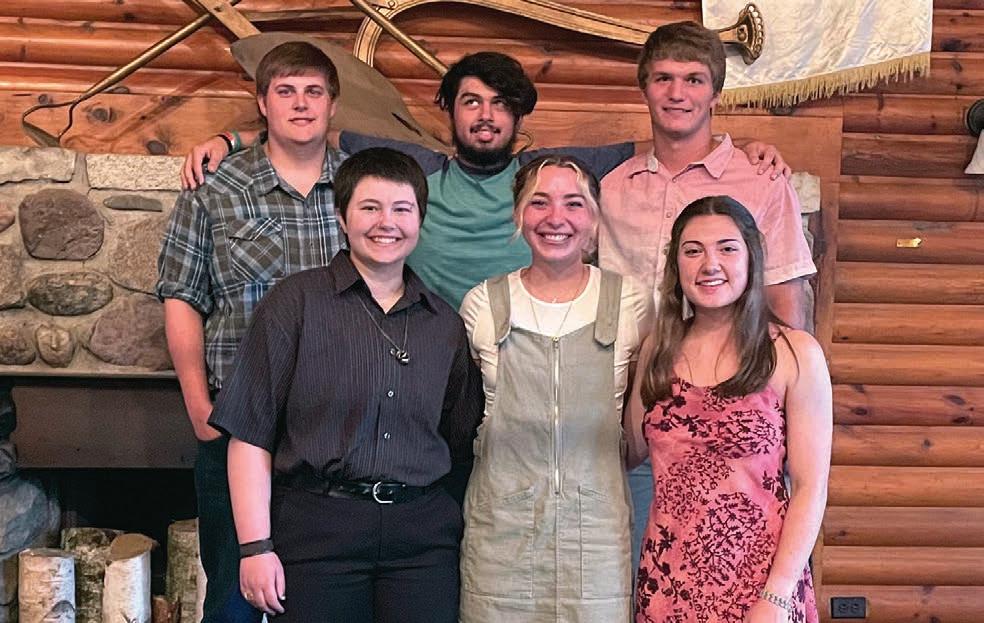
Growing up attending Farmers Union farm safety and leadership camps, Tyler Hanson a 2021 graduate of Britton Hecla High School said initially he was nervous to run for the position because he had to give a speech. But then, he put his fears aside and utilized the public speaking skills he developed through the years attending Farmers Union Leadership Camp.
“I focused my speech on how important Farmers Union is to me and the reasons I stay involved,” explained Hanson, who will attend North Dakota State College of Science to study diesel mechanics this fall.
In this national leadership role, Hanson and the other youth will put their speaking skills to work advocating for agriculture when they attend the 2022 National Farmers Union Fly-In this September.
“I am excited to learn about how Farmers Union uses policy to impact legislation,” said Nightingale, a South Dakota State University freshman studying ag/bio systems engineering. “I also look forward to listening to the Congressional leaders during the Fly-In. This will be my first time in D.C.”
Throughout the year, the young adults will also fine tune their communication
Kolousek Family
Continued from Page 11
“I appreciate organizations hosting tours like this because it gives me and other producers a chance to pick up some new practices and learn from experts and learn from producers how they implement different practices into their system,” Davis said.
Providing South Dakota farmers and
skills, working together to plan the 2023 NFU All-States Leadership Retreat.
Lake Preston senior Garrett Kruger is eager to get started. “Serving as an NYAC has been a dream of mine,” explained Kruger, who currently serves on South Dakota Farmers Union Junior Advisory Team. “I am excited to plan camp and share all the traditions of All States Camp with those who attend next year.”
In addition to Fly-In and planning the 2023 retreat, the NYAC team will also present during the 2023 National Farmers Union Convention held this March in San Francisco.
The South Dakota youth will serve alongside Emmalee Sathrum, Minnesota; Olivia Roth, Wisconsin; and Kathleen Marty,
ranchers with educational opportunities is a focus of South Dakota Farmers Union and among the reasons the organization partnered with SDSHC to sponsor the tour, explained Karla Hofhenke, SDFU Executive Director.
“Making educational opportunities accessible is one of many ways we work to support our state’s family farmers and ranchers,” Hofhenke said. “We know farmers and ranchers don’t have any time to
Colorado.
“This year’s All-States retreat was a testament to the principles of NFU,” said Rob Larew, NFU President. “Education is at the core of our work, so opportunities like this All-States retreat give us a chance to engage with the next generation of leaders and show just how powerful cooperatives are for their members and communities.”
Participants in the retreat ranged from ages 18 to 22 and heard from speakers including motivational speaker and South Dakota Farmers Union member Toby Kane, NFU Vice President of Advocacy Mike Stranz, as well as NFU President Rob Larew and Wisconsin Farmers Union President Rick Adamski. ■
spare, so we look for quality opportunities, like this soil health tour, to provide them with information to make their time off the farm or ranch worthwhile.”
To learn more about educational opportunities provided to South Dakota farm and ranch families, and to watch a video of the rainfall simulator demonstration, visit www.sdfu.org and click on this article in the news release link under the News and Events tab. ■ By Lura Roti for SDFU
National Farmers Union Youth Advisory Council: Front row: Emmalee Sathrum, Minnesota; Kathleen Marty, Colorado; and Olivia Roth, Wisconsin. Back row: South Dakota Farmers Union members Tyler Hanson, Britton; Garrett Kruger, Lake Preston; and Levi Nightingale, White Lake.
14 August 2022 www.sdfu.org
Union
South Dakota Famers Union to President: If You Want to Increase Fuel Supplies Come See What We Are Doing Here
Forget Saudi Arabia: Biden Should Have Gone to South Dakota. That was the message from South Dakota Farmers Union President Doug Sombke in an editorial in the Argus Leader newspaper this week.
“We have a homegrown product that has been proven to significantly improve gasoline quality and save billions at the pump while dramatically boosting our farmers, the environment, public health and the nation’s energy security,” said Sombke.
He noted that thanks to nationwide
use of 10 percent ethanol blends, we are displacing more than 400 million barrels of oil annually. Increasing blend levels to 30 percent as is successfully being done in South Dakota could replace more oil than we currently import from Saudi Arabia and Russia combined, providing more than $100 billion in savings to U.S. consumers.
Sombke said the pathway to capture these benefits is simple – President Biden could direct his EPA administrator to establish a nationwide E30 “clean octane”
standard, which EPA has the statutory authority to do under the Clean Air Act.
“Ethanol’s high octane will replace the toxic carcinogens currently used to increase octane and reduce the carbon emissions from today’s gasoline. It is a health, economic and ghg and climate initiative rolled into one.”
For more information contact Karla Hofhenke at khofhenke@sdfu.org.
Read Argus Leader July 17 Editorial Below:
Editorial by Doug Sombke, South Dakota Farmers Union President & Farmers Union Enterprises President
President Biden’s visit to Saudi Arabia to beg for more oil seems unnecessary to us — he could have saved himself a long trip by coming to see what is being done right here in South Dakota. Sky high gas prices are inflicting pain on our budgets and our psyche in part because we feel helpless. However, we can do something about it and it doesn’t require us to get on bended knee to Saudi oil sheiks. Fortunately, we have a homegrown product that has been proven to significantly improve gasoline quality and save billions at the pump. Not to mention, it would dramatically boost our farmers, the environment, public health and the nation’s energy security.
Today, ethanol displaces more than 400 million barrels of oil each year thanks to nationwide use of E10. Transitioning to a national E30 standard—which the U.S. Environmental Protection Agency (EPA) has the statutory authority to do (some say legal obligation)—would reduce U.S. oil imports by 1 billion barrels per year. That is more than $100 billion staying here at home to improve our economy.
Experts at the U.S. Department of Agriculture and Argonne National Laboratory have concluded that corn ethanol produced with precision agriculture and other conservation practices can reduce greenhouse gas emissions by 50 percent to 76 percent compared to gasoline. Other experts predict that over the next several years, High Octane Low Carbon (HOLC) fuels, such as ethanol, will be classified as ultra-low carbon fuels, surpassing the greenhouse gas benefits of vehicles running on electricity produced from coal and natural gas. Higher octane fuels would also allow automakers to dramatically increase fuel economy and reduce carbon emissions, benefiting both the environment and public health.
For many years now, S.D. Farmers Union has supported the pioneering work of Glacial Lakes Energy in Watertown which every day proves that HOLC E30 blends work well in the existing fleet. Millions of trouble-free miles have been driven on E30 fuels, and lucky Watertown-area consumers have saved millions of dollars by purchasing a superior, high octane, cleaner burning gasoline.
Octane is the most important property in designing an internal combustion engine—the higher the octane the better. That is why automakers recently urged EPA to encourage the use of HOLC fuels in the existing fleet “as soon as possible”. Ethanol’s octane properties are superior to the only other available octane booster: benzene-based BTEX synthesized from crude oil. BTEX is the most expensive, toxic and carbon intensive gasoline component. In the U.S., a typical gallon of gasoline contains 20 percent BTEX and 10 percent ethanol.
When Congress banned leaded gasoline in 1990, it knew that BTEX posed an even greater threat to public health and the environment, which is why it required EPA to get the “greatest degree of emission reduction achievable” by replacing carcinogenic BTEX with ethanol. EPA has thus far refused to comply. However, with a stroke of his pen, President Biden could direct his EPA Administrator to establish a nationwide E30 “clean octane” standard, which would save consumers billions of dollars in lower gasoline costs, reduce U.S. oil imports by 1 billion barrels a year—far more than we import from Saudi Arabia and Russia combined—and substantially reduce mobile source toxics and carbon emissions. A major bonus would be the enormous boost to the Midwestern farm economy.
So, Mr. President, the answer to our nation’s fuel challenge lies right here in South Dakota. We hope you can visit us soon to see it for yourself.
— Doug Sombke, South Dakota Farmers Union President & Farmers Union Enterprises President
www.sdfu.org August 2022 15
Farmer
Union Farmer
Packing Plant Continued from Page 12
process and other details will be made available later.
The predicted $1.1 billion plant will be unlike any currently operating in the United States, she said, and should employ about 2,500 people, with entry level positions paying about $28 per hour and consisting of a “tech position on the line” rather than a meat cutting job.
The plant is to be privately held and privately financed through Kingsbury and Associates and Sirius Realty. “There are no other investors,” she said.
“There are no facilities like this in North America to draw a comparison,” she said, adding that the research team identified 11 similar high-tech plants globally, boiling it down to four that they are researching to pick and choose aspects that could work for the Rapid City plant.
“We will take the sweatshop mentality out of the packing facility completely. We’re using airknife technology on the line rather than actual knives,” she said.
Methane gas technology will power the facility, she said, which will “take the odor out of the equation.” She believes the plant will put power back into the grid “based on our green energy we’re creating on site.”
Industrial engineers, electrical engineers, computer engineers, robotic engineers and more have teamed up to help determine how the plant can operate most efficiently.
The recently announced Black Hills Industrial Park is the preferred site and is adjacent to Highway 79 and Old Folsom Road, just south of Rapid City.
David Uhrig, herd manager for Mt. Rushmore Angus Ranch of Hermosa, S.D., is hopeful this plant is the answer the industry needs.
“We need more packing capacity, and it should be a boon for the economy,” he said. “This is huge. To wrap our minds around this and say logistically ‘can you make this all work?’ I just don’t know, but I’ve always been for the underdog,” he said.
“The huge part is that this will be U.S.owned and they will be killing U.S. cattle. That’s a quality that doesn’t exist on this scale right now,” he said.
He also points out that the new plant won’t be in competition with smaller, custom plants like Wall Meats and won’t compete with farmers markets and ranchers selling their own beef. “This is something to compete directly with commerciallyproduced beef, and that’s what the industry is saying as a whole is we need that one extra bidder. Since this isn’t owned by one of the corporate packing plants, they could potentially be a new bidder,” he said.
And don’t count out the bison, said Uhrig. “I think that bison line is going to play a bigger role than some of us are giving it credit for,” he said.
Gary Cammack, a rancher, state senator and ranch supply story owner from Union Center, S.D., echoed Uhrig’s thoughts regarding bison.
“The buffalo/bison slaughter part of it is intriguing. That’s definitely a niche that needs to be filled. The buffalo industry has grown a lot and I know they are needing
Around the State with Farmers Union Summer Spotlight

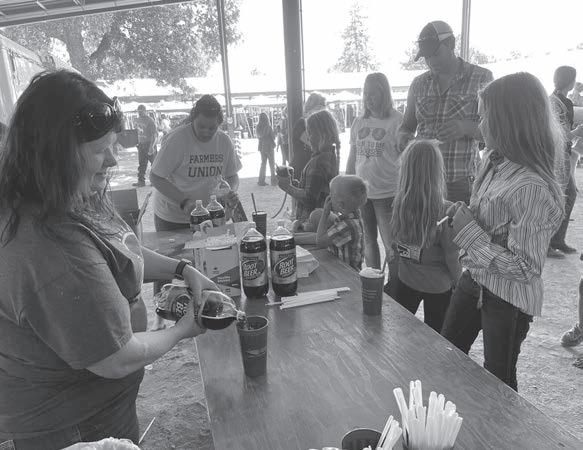
slaughter capacity,” he said.
As for the success of the plant overall, Cammack said it remains to be seen, but if it becomes a reality, it is sure to help the cattle industry locally.
“It certainly will have a positive influence. As much as anything, it gives one more aggressive buyer on the scene to give an alternative bid,” he said.
Cammack said he has “considerably more questions than answers” at this point, although he did speak briefly with Kingsbury before the announcement was made.
Others have doubts, including access to sufficient labor, cattle numbers and buying practices of the big four packers.
Darrell Hoar, who bought cattle for Rapid City’s Black Hills Pack from 1960 until it burned in 2002, has concerns about the future of a mega plant in the Black Hills of South Dakota.
“There aren’t 8,000 head of cattle per day to be procured. There aren’t that many cull cows and bulls in the trade territory,” said Hoar. He fears that rising fuel costs and a growing number of absentee cattle owners who may already have their cattle contracted, will make it difficult for the plant to maintain an 8,000-head-per-day slaughter.

“There aren’t ma and pa feedlots left. The cattle in the feedlots are owned by absentee owners out of the area and many of them are already committed to a buyer.”
Black Hills Pack, built in 1910, slaughtered
South Dakota Farmers Union members and staff are making a difference in rural communities across South Dakota.
Packing Plant
16 August 2022 www.sdfu.org
Continued on Page 19
Union Farmer

Ag Teachers Mentor the Next Generation of Agriculture Leaders
Across South Dakota more than 10,037 youth are enrolled in agriculture education classes and members of FFA. Founded in 1928 as Future Farmers of America, today’s FFA remains rooted in agriculture while firmly focused on equipping youth with leadership and personal development skills necessary to succeed in careers on and off the farm today and into the future.
Leading the charge are agriculture education teachers who also serve as FFA advisers. Through our educational programming and annual Farm Safety Quiz Bowl, South Dakota Farmers Union works to support these educators as they mentor the next generation of agriculture leaders.
To learn more about the work they do, we recently caught up with three FFA advisers during the 2022 South Dakota Association of Career and Technical Educators Conference. ■ By Lura Roti for SDFU
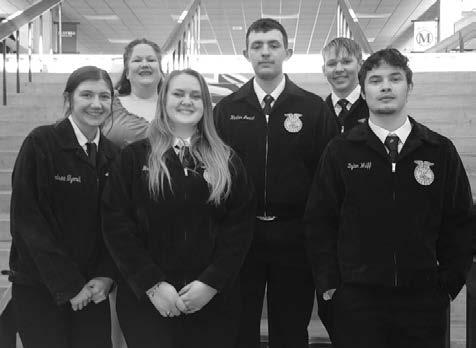
Brady Duxbury, Wessington Springs FFA Chapter

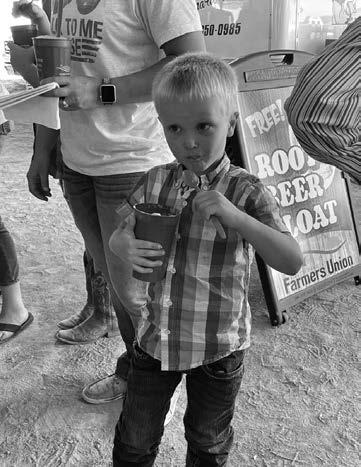
Q: Let’s start at the beginning, why did you want to be an FFA adviser/ag education teacher?
A: I became an ag teacher because my ag teacher cared about me. I was kind of a goofy little kid. I didn’t say very much. I remember my freshman year, my FFA adviser told me that it didn’t matter what I said, I was going to be doing the Creed Speaking contest, and that’s just the way it was.
And ever since that moment, I blossomed. I became outgoing and I learned, I could speak, and I had a voice. I want to give
Tracey Walsh, Kimball FFA Chapter
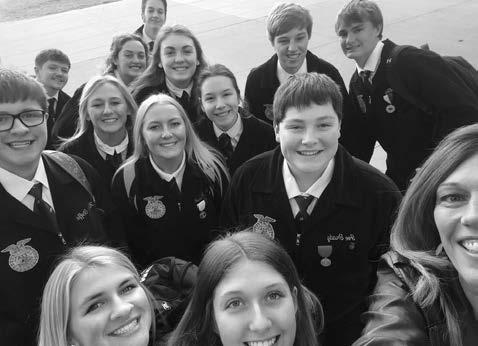
Q: Let’s start at the beginning, why did you want to be an FFA adviser/ag education teacher?
A: In high school, my FFA adviser made a huge difference in my life, and I was very involved in FFA. And I wanted to give back to FFA members and work to make a difference in their lives like my teacher did in mine. Also, I have a huge passion for agriculture and advocating for agriculture. So, I feel like this career is a good way to combine all of those interests.
Tracy Chase, McCook Central FFA Chapter
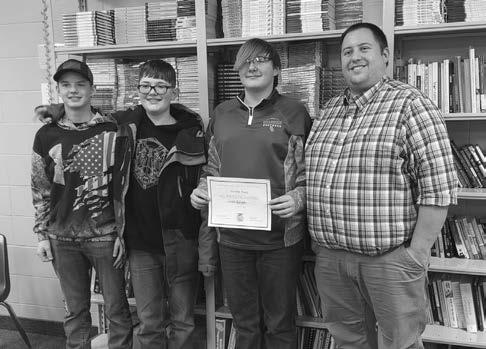
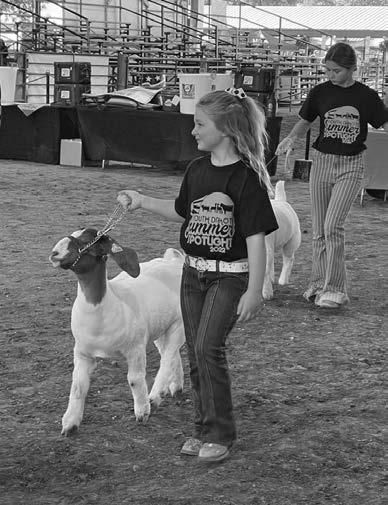
Q: Let’s start at the beginning, why did you want to be an FFA adviser/ag education teacher?
A: I became an ag teacher because of Terry Rieckman. We were teaching together at McCook Central High School. I was the middle school high school science teacher, and he was the ag teacher.
Ten years ago, he said to me “I got an idea. Why don’t we team together, because wouldn’t it be great if we could pull science and ag that are already together, together even more and show people how they
www.sdfu.org August 2022 17
Teachers Mentor Continued on Page 18
students a voice. I want to be an advocate to help students realize their potential –even if they don’t even see it in themselves. And that’s why ultimately the reason I went to school for this. I love the FFA. I love the competition. I love with the learning and the real-life skills that open students’ eyes to potential they didn’t know.
Q: FFA provides so many opportunities for students. What is one of your favorite career development events?
A: Parliamentary Procedure. It’s a fun competition. It’s very “real world” giving students skills that very few have, but these are skills that are still used in so many organizations to run meetings – from
Teachers Mentor
Q: FFA provides so many opportunities for students. What is one of your favorite career development events?
A: My students really love Farmers Union’s Farm Safety Quiz Bowl – so I guess it’s one of my favorites too. They actually fight over who gets to be on the team. I really enjoy Parliamentary Procedure, but my students don’t love it as much as I do. And then there are the natural resourcerelated Career Development Events … there are so many good options, it is difficult to narrow it down to one favorite.
connect?”
I loved his idea. We went to the superintendent with a plan to make me the assistant FFA adviser and incorporate ag in our high school curriculum a bit more with science and STEM (Science, Technology, Engineering & Math) portions.
I then became certified in Curriculum for Agricultural Science Education (CASE) Animal Science and CASE Agriculture, Food and Natural Resources (AFNR).
church boards to school boards, local, state and national government.
I actually learned a lot about this contest because I had a group of sophomores who wanted to try it out. They were so excited, and even though I had no idea what I was doing, over the course of the next three years because of their excitement I doubled down on my knowledge and we worked and we worked and we worked. We won the state competition and then went to nationals, and we made it to the national semi-finals.
My take on Career Development Events, is I am willing to learn anything as long as there are students who are passionate about it. I will do everything in my power, to try and help them do the best that they can do.
Q: How can community members support their local FFA adviser?
A: What’s your gift or talent? Consider visiting with your local FFA adviser about coaching a team. Or if your talent is baking, consider bringing treats for students to enjoy during practices. Or, if you do not have time, but you have resources to share, visit with your FFA adviser about what their chapter needs. ■
Q: Because you work with students, based on what you see in the classroom every day, what are your thoughts about the future of agriculture?
A: Well, based on the kids I get to work with, if they continue to grow their skills whether they are involved in production agriculture or a different area of agriculture, I think our future is bright.
I think we’ve got a lot of challenges to face. I think there’s always been challenges, but it seems like the challenges that we face right now seem to be bigger somehow. But I think these students are ready. ■
Q: FFA provides so many opportunities for students. What is one of your favorite career development events?
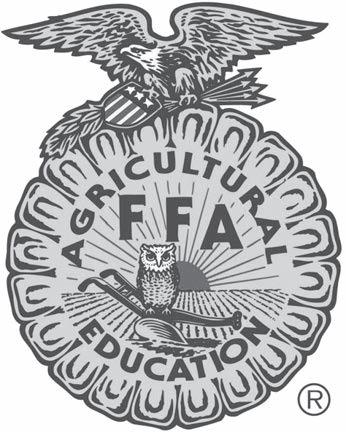
A: Because of my background, growing up on a farm and becoming a science teacher who became an ag teacher I jumped into the Agriscience Fair. To me it was a nobrainer. I love this career development event because students learn communication skills, writing skills, math – it has so many real-world applications.
Since 2016, eight individuals or teams have won the national contest. Some students have even gone on, and because of their agriscience project, some students now have internships and careers.
Q: Because you work with students, based on what you see in the classroom every day, what are your thoughts about the future of agriculture?
A: When I was growing up, a kid on the farm, I never would have thought of this thing called a drone that could show me all these photos and takes precision ag to whole different level.
But even though the future of agriculture will look much different than when I was growing up on the farm, the future looks good.
These students are raised with technology. These students are the ones who will think of a new app to use on their farm. Or they are going to be the ones who are going to find a better way to do things. They are the ones who have the ideas we need to be ready for ■
“I want to give students a voice. I want to be an advocate to help students realize their potential –even if they don’t even see it in themselves.”
– Brady Duxbury, FFA Adviser, Wessington Springs FFA Chapter
“Well, based on the kids I get to work with, if they continue to grow their skills whether they are involved in production agriculture or a different area of agriculture, I think our future is bright.”
– Tracey Walsh, FFA Adviser, Kimball FFA Chapter
“Even though the future of agriculture will look much different than when I was growing up on the farm, the future looks good.”
– Tracy Chase, FFA Adviser, McCook Central FFA Chapter WALSH Continued CHASE Continued
Union Farmer
Continued from Page 17
18 August 2022 www.sdfu.org
BRADY DUXBURY Continued TRACEY
TRACY
Union
Packing
beef and pork. When Hoar took a job there in 1960, the plant was slaughtering about 40 head per day, but had grown to about 700-800 head per day when it burned in 2002. The Pack processed mostly cull cows and bulls, but also processed finished cattle. “We bought from five states and even a few from Canada. In those days, we bought them direct from ranchers, feedlots and auctions. A lot of those feedlots are dead and gone today,” he said.
Because of his experience in the packing business, Hoar knows a lot of the “what ifs.” He says 2,500 willing employees will be difficult to procure, and he fears that the big packers will undercut the fledgling plant to prevent it from getting a foothold in the beef industry. “The big boys, whoever they may be, will outbid or raise the price just to drive them out of the country. They raise the cost of cattle to take any margin out. They will lose money but in the long run they’ll run the new plant out of business.”
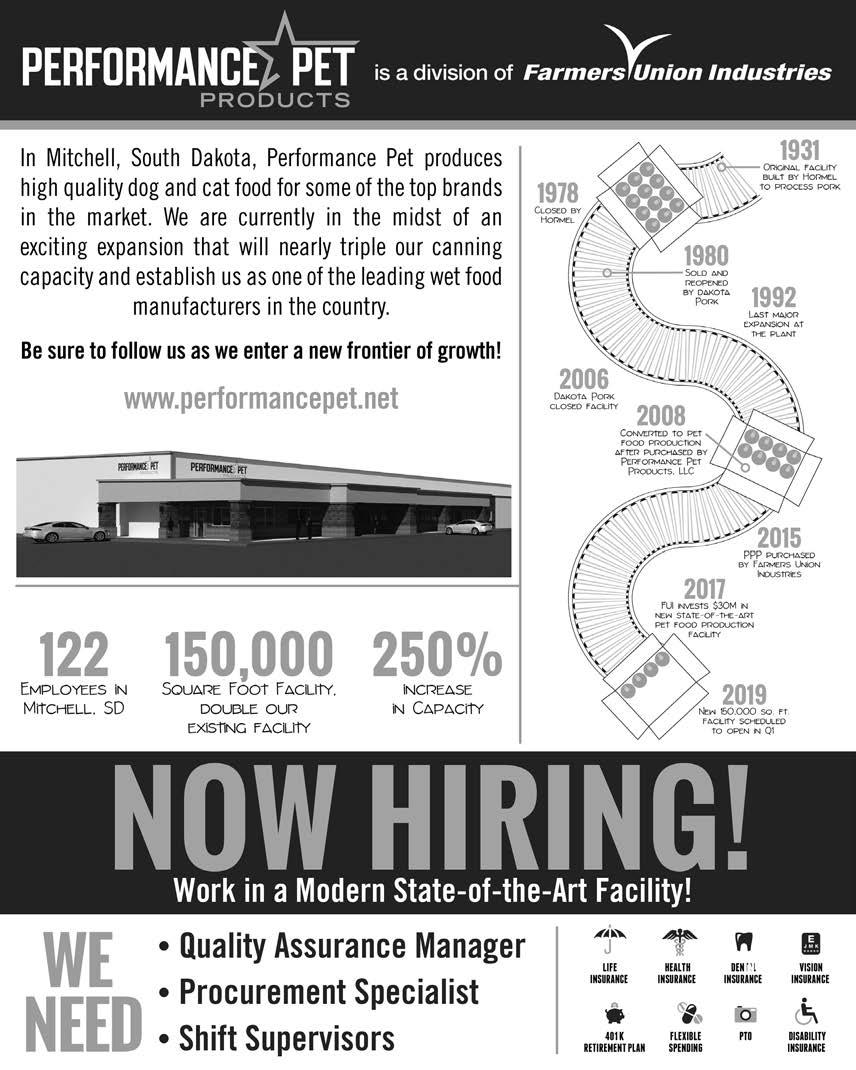
“I’ve seen this come and go. And I just hate to see individual people get involved and lose a lot of money,” he said.
The local cattle industry took a blow when Black Hills Pack burned, he says.
Hoar said he witnessed many packing plants close their doors during his time as a cattle buyer. “A lot of them were old and outdated. They couldn’t keep up with USDA regulations,” he said.
He said he saw the following plants close down during his tenure with Black Hills Pack: Midland Empire in Billings, Mont.; Pierce Pack, Billings; Great Falls Meat, Great Falls, Mont.; Miles City Pack, Miles City, Mont.; Rocky Mt Pack, Casper, Wyo.; Sheridan Meats, Sheridan, Wyo.; Gering Pack, Gering, Neb.; Swift Pack, Gering, Neb.; Swift Pack, Watertown, S.D.; Barnes Pack, Huron, S.D.; Huron Dressed Beef, Huron, S.D.; Meiliman Pack, Sioux Falls, S.D.; Morell, Sioux Falls, S.D.
Swade Reis
“Swade’s a great kid,” Pat said. “He approached me a few years ago about selling his eggs at our store, and I told him I’d love to give it a try. Swade’s Eggs have proven to be very popular. I’m very impressed with his work ethic. He’s an active young man who exudes confidence, taking part in wrestling, band, rodeo while doing all this work to provide the community with eggs.”
From their interaction, Pat said it’s clear, “He’s learning the business end of the world. I’ve worked with him when we negotiate on the price. With the recent outbreak of avian flu, eggs are in big demand. Prices reflect market demand and he’s looking at additional ideas. He’s approached me about
selling duck eggs. And that’s a possibility once he gets his operation set up.”
While others may complain about the younger generation, Pat said, “I believe he’s a role model for today’s youth. He knows you can do a lot if you put in the work.” Swade also sells eggs at the Chamberlain Food Center.

“When I first started,” Swade said, “I’d hear from people who would say, ‘Hey, I saw your eggs at the store.’ That’s kind of a cool experience especially since some go across the state or into other states. Who knows where my eggs could go from my little business on my ranch?”
■ By Connie Groop, originally published in Tri-State Livestock News
www.sdfu.org August 2022 19
Continued from Page 6
Farmer
Plant Continued from Page 16 Packing Plant Continued on Page 22
Union Farmer

CONGRESS PASSES HISTORIC CLIMATE, TAX AND HEALTH LEGISLATION
August is usually a quiet month on Capitol Hill, as Congress adjourns from session for its annual summer district work period. Representatives and senators typically head back to their districts for constituent meetings, town halls and loads of casework requests and projects.
This August however, it’s been anything but quiet, as both the House and Senate pushed forward with a legislative package pursuing key domestic priorities, particularly related to addressing climate change and economic issues.
Titled the Inflation Reduction Act of 2022 (IRA), the bill invests hundreds of billions into renewable, clean energy projects to fight climate change, lowering healthcare costs and making corporations pay their fair share in taxes. It is widely considered to be the largest climate investment by Congress in U.S. history.
Following House passage on Aug. 12, President Biden was expected to sign the bill into law within a week. NFU strongly supports this landmark legislation and looks forward to ensuring proper implementation over the next several years.
LEGISLATIVE BREAKDOWN: BEHIND THE SCENES AND IN THE WEEDS
On July 27, Senate Majority Leader Chuck Schumer (D-NY) and Sen. Joe Manchin (D-WV) issued a joint statement announcing a deal reviving Senate Democrats’ efforts to pass a social spending bill, through the budget reconciliation process, which allows the Senate to pass legislation through a majority vote without the threat of a filibuster. This process sunsets most provisions after 10 years and requires the legislation to make budgetary changes.
This legislative process began with a social spending and safety net framework, central to President Biden’s domestic agenda, known as “Build Back Better” (BBB), which NFU supported when it was first proposed. The White House proposal was marked at roughly $3.5 trillion, but the first Senate version was put forward at about $1.75 trillion. In November 2021, the U.S. House passed its version of Build Back Better, at around $2.2 trillion. Prospects for BBB were dashed in late December 2021 when Manchin announced his opposition, due to concerns about rising inflation.
What followed over the next seven months were intense negotiations between Senate Democrats to come to an agreement on passing some of the legislative provisions from BBB. Negotiators kept details largely out of public
view, and a period of soaring prices and conflict overseas presented major obstacles. Despite this, NFU remained committed to its policy priorities –including how farmers and ranchers can be part of the solution to addressing climate change.
The IRA (also known as H.R. 5376) includes $369 billion in “energy security and climate change” spending and another $64 billion on an Affordable Care Act extension (totaling $433 billion) over 10 years. The bill also allows Medicare to negotiate drug prices, aiming to reign in skyrocketing prescription drug costs.
The bill will be funded by roughly $740 billion in new revenues over the next 10 years, imposing a 15 percent corporate minimum tax, imposing a small excise tax on corporate stock buybacks and stronger IRS enforcement measures. The Congressional Budget Office recently estimated the bill will raise revenues and reduce the deficit, easing inflationary pressures.
A BOOST FOR CLIMATE-FRIENDLY AGRICULTURE AND RENEWABLE ENERGY
Key agriculture provisions in the IRA which total about $40 billion over 10 years.
Climate-Smart Agriculture: $20 Billion
• $8.45 billion for the Environmental Quality Incentives Program (EQIP).
• $6.75 billion for the Regional Conservation Partnership Program (RCPP).
• $ 3.25 billion for the Conservation Stewardship Program (CSP).
• $1.4 billion for the Agricultural Conservation Easement Program (ACEP).
• $1 billion for Conservation Technical Assistance (CTA).
• $300 million for NRCS to carry out a carbon sequestration and GHG emissions quantification program.
Renewable Energy and Biofuels: $14 Billion
• $1 billion for the cost of loans under the Rural Electrification Act of 1936 by the USDA RUS; the loans are for electric generation from renewable energy (solar, wind, hydropower, biomass or geothermal) for resale to rural and nonrural residents.
• Nearly $2 billion for the Rural Energy for America Program (REAP), and the grant limit was raised to not more than 50 percent of project cost (eligible entities are rural small businesses and agricultural producers).
• $500 million for biofuel infrastructure; grants with up to 75 percent cost share
Rob Larew National Farmers Union President
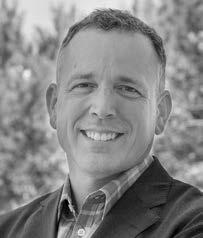
to fund infrastructure improvements for blending, storing, supplying or distributing biofuels.
• $9.7 billion in assistance for rural electric cooperatives; grants, loans, the cost of loans and loan modifications for rural electric co-ops to purchase renewable energy, renewable energy systems, carbon capture and storage, and energy efficiency improvements on generation and transmission systems.
USDA Farm Loan Relief and Assistance for Underserved Farmers: $6 Billion
In March 2021, the American Rescue Plan Act (ARPA) established a debt relief program for Black and minority farmers, attempting to reverse decades of discrimination by the USDA. It authorized the USDA to offer payments worth 120 percent of a minority farmer’s loan balance, but this program has been blocked by federal courts.
The IRA scraps the stalled ARPA program and creates a new debt relief program, adding new funding to support underserved farmers, ranchers and foresters. This includes a new debt relief program with $3.1 billion for aid to distressed holders of Farm Service Agency direct and guaranteed loans. It also designates $2.2 billion for payments of up to $500,000 each to farmers who “experienced discrimination” prior to Jan. 1, 2021, in USDA farm lending programs.
FINAL PASSAGE AND THE ROAD AHEAD
The Senate voted 50-50 on final passage in the late afternoon on Aug. 7. Vice President Kamala Harris presided over the session and cast the tiebreaking vote in favor of the IRA, to conclude a nearly 30-hour long session of debate and votes on amendments, also known as a “vote-a-rama.” The following week, the House of Representatives returned and passed the bill, by a largely party-line vote of 220-207.
Because this bill was passed through the budget reconciliation process, there will likely be attempts to rescind or repurpose some of these funds. The funding in agriculture committee jurisdiction might be able to be used in the 2023 Farm Bill. This could provide more flexibility for writing the next farm bill, and NFU will closely monitor the implementation process for the IRA.
■ Current as of Aug.12, 2022
20 August 2022 www.sdfu.org
From the President.... See You at the Fair
Doug Sombke, SDFU President
In just a few days we’ll be celebrating family farmers and ranchers together at the South Dakota State Fair.

I am counting down the days – it’s a habit. Attending the South Dakota State Fair is a family tradition. Catching up with friends from across the state and watching the next generation in the show ring is energizing.
Our State Fair is ag-based, which is the reason Farmers Union Day at the State Fair is so special. It is a day when SDFU ensures the people of agriculture are recognized and celebrated. And during our Farmers Share Lunch, Farmers Union helps remind consumers where their food comes from and who is responsible for the work of producing it.
The timing of State Fair is also unique because it falls just a week ahead of the 2022 National Farmers Union Fly-In, where we share Farmers Union members policy with congressional leaders in D.C. Your stories about the challenges you face on the farm or ideas you have to make things better for other family farmers and ranchers help when we advocate for policy.
Speaking of policy, the current Inflation Reduction Act reflects some elements of Farmers Union policy. This act contains legislation that would:
• Provide funds for infrastructure to support higher ethanol blends.
• Lower the cost of prescription medications.
• Provide dollars to electric cooperatives to fund investment in wind and solar energy.
• Increase transparency of corporations (including the Big Four packers) by funding IRS auditors to ensure corporations are paying their fair share with a 15 percent minimum tax on the income that big corporations report to their shareholders.
One important topic this act does not cover is the Right to Repair. This bill is in the works and will be one of the talking points members will advocate for during the Fly-In.
Advocating for family farmers and ranchers is also a focus of the State Fair Forum. This year’s forum topic is Strengthening South Dakota’s Beef Industry. Among the topics we will discuss is the beef plant proposed for Rapid City. Panelists will include Megan R. Kingsbury, Kingsbury & Associates - President/CEO; Dale Bednarek, Farmers Union Industries; and James Halverson, South Dakota Stockgrowers Executive Director.
I look forward to learning more about this project and hearing from you. Please attend and be ready with your questions.
Sincerely,
Doug Sombke, President South Dakota Farmers Union
Rep. Dusty Johnson 202-225-2801 / 855-225-2801

reid.rasmussen@mail.house.gov
Union Farmer
Sen. Mike Rounds 202-224-5842 / 844-875-5268
logan_penfield@rounds.senate.gov
Sen. John Thune 202-224-2321 / 866-850-3855
ryan_donnelly@thune.senate.gov
South Dakota Union Farmer, ISSN 0745-8797, publishes 9 times per calendar year, with issues printed in March/April, March/April, May/June, July, August, September, October, November and December. Periodical postage paid at Madison, S.D.
Karla Hofhenke, Publisher Lura Roti, Editor
Wendy Sweeter, Copy Editor
Diane Martinson, Layout & Design
All information for publication must be submitted by the 15th of the month. You may submit items to address below or email items to: sdfu@sdfu.org
POSTMASTER: Address changes to: SDFU, PO Box 1388, Huron, S.D. 57350-1388
Contact SDFU • 605.352.6761
1410 Dakota Avenue South, PO Box 1388, Huron, SD 57350 www.sdfu.org sdfu@sdfu.org
SDFU State Office Staff
Karla Hofhenke............ext. 114 Executive Director Huron
Rocky Forman. ext. 117 Member Services Coordinator Huron
Kelli Peterson ..............ext. 116 Administrative Assistant Huron
Doug Bruckner ext. 118 Controller Wessington Springs
Luke Reindl.................. ext. 122 Comm. & Policy Specialist Wessington Springs
SDFU Board of Directors
Doug Sombke.........President Groton
Wayne Soren Vice President Lake Preston Mike Miller ............... District I Freeman Scott Kolousek District II Wessington Springs
Gail Temple District III Clark
David Reis District IV Oacoma
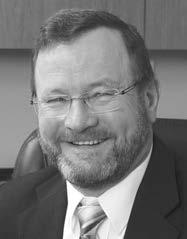
Dallis Basel ..............District V Union Center
Oren Lesmeister District VI Parade
Chad Johnson District VII Groton
Contact NFU National Farmers Union 20 F Street NW Suite 300 Washington, DC 20001
Rob Larew, President ~ Jeff Kippley, Vice President
Darin Von Ruden, Secretary ~ Doug Sombke, Treasurer 202.554.1600 www.nfu.org
A PUBLICATION OF SOUTH DAKOTA FARMERS UNION
Congressional Leaders Contact information:
www.sdfu.org August 2022 21
Pam Lunzman Named 2022 Outstanding
CSR of the Year in South Dakota

The National Alliance for Insurance Education & Research has announced that Pam Lunzman is the 2022 Outstanding CSR of the Year recipient for the state of South Dakota..
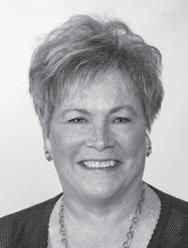
To qualify for this top state honor, Pam Lunzman submitted the winning essay on the topic, “Transferable Skills are learned from experience which includes prior careers, education, volunteer work, or personal encounters. What are the top three skills you transferred from outside the insurance industry to your current job role? Discuss how you leverage your skills, continue to develop and evolve them, and how you transfer your expertise to others to ensure perpetually exceptional customer service.”
Additionally, Lunzman was selected for having demonstrated outstanding service and professionalism within the insurance community.
Lunzman began her insurance career as a customer service representative
in 2005. She has been associated with Farmers Union Insurance /Tom Farber Agency in Britton, S.D., since then, serving over the past 17 years in various capacities; Crop Insurance, Personal lines, Claims, Education, Bookkeeping, Office Management and multitude of additional responsibilities. Pam became a licensed Crop Resident Producer in November of 2007. She has been a member of the National Alliance of Insurance since January of 2011 when she also received and continues to maintain her CISR designation. Pam previous experience and careers in mental health, as a Licensed Professional Counselor, Licensed Social Worker and a variety of additional service jobs have led to her well-rounded approach to customer service excellence. In addition she has served on many volunteer boards and donated many hours in service to her church and her home and work communities. She was additionally awarded a local People’s Choice award for excellence in customer service.
“Pam Lunzman was chosen as a state winner for exemplifying the characteristics and qualifications required to be eligible for the prestigious award,” stated Dr. William
T. Hold, Ph.D., CIC, CPCU, CLU, Executive Chairman of the National Alliance. “Pam Lunzman represents the backbone of the insurance community, those customer service representatives distinguished for providing exceptional service on a daily basis.”
Lunzman receives a framed certificate, embossed with the special Outstanding CSR of the Year bronze medallion symbol. The National Outstanding CSR of the Year Award carries a $2,000 cash prize and a scholarship for the recipient’s employer to any program offered by the National Alliance. The national winner also receives a distinctive gold and diamond lapel pin cast with the Outstanding CSR of the Year emblem. Additionally, the winner’s name will be inscribed on a sculpture permanently displayed at the national headquarters in Austin, Texas.
For further information regarding the 2022 Outstanding CSR of the Year Award, contact the National Alliance, P.O. Box 27027, Austin, TX 787552027; 800-633-2165 website: www. TheNationalAlliance.com ■
But Kingsbury believes she can keep costs low enough to be successful. “We’ll be the low-cost producer and the low-cost producer always wins.”
Kingsbury sees that ranch families are struggling to be profitable. She hopes by building a large packing plant in Rapid City, South Dakota, she can “fundamentally fix the problem by putting in a packing facility that will move the needle and fight the “big four.”
Kingsbury said her mother grew up on a ranch in the Kadoka area and her father’s
family is from the Rapid City and Keystone areas.
Calling herself a fifth generation Angus cow/calf producer, she said she grew up in the Minneapolis area but spent about half of her time on the family ranch in South Dakota.
Her grandfather gave her a bred heifer when she was 5 years old, as he did for all of the grandkids.
“We all kept going in the cattle business,” she said.

Kingsbury graduated from an East Coast
college, “put down roots in South Carolina” and worked there until about a year and a half ago when she decided to begin to move her business to western South Dakota. “I wanted to bring those offices to Rapid City and fundamentally fix the problem (low profit margins for ranchers) by putting in a packing facility that would move the needle and fight the big four,” she said.
“There is plenty of wealth to go around, we just need to be sure it’s not being held at the top.” ■
Union Farmer
Packing Plant Continued from Page 19 22 August 2022 www.sdfu.org
Thank You
Thank you for sponsoring the 4-H Jr. boys all around.
Kolt Mendenhall
***
Thank you for sponsoring the Heartland 4-H rodeo! We couldn’t have done it without your help!
Charleigh Brewer
***
Thank you so much for being an Elite sponsor at the Clark County Prospect Show. We appreciate your support!
Sincerely, Clark County Project Show Committee
***
Thank you for participating in the field tour at Scott & Amber’s. SDSHC greatly appreciates your efforts for S.D. farmers and ranchers. Have a great rest of the summer! Keep in touch.
Best regards, Cindy South Dakota Soil Health Coalition
COOK’S CORNER
Beef Taco Pie
Filling:
1 lb. ground beef
¼ c. onion, chopped
2 T. taco seasoning mix
Departings
Delores Whitmyre of Webster, S.D., passed away July 23, 2022. Survivors include her children, Patricia and Allen Sass, Debra and Jeffrey Schiley, and Robert and Tonia Whitmyre. She was preceded in death by her husband, Maynard Whitmyre.
Eugene “Gene” Stohr, of Clear Lake, S.D., passed away March 13, 2022. Survivors include his wife, Lynette; and children Brenda Hanten, Glenda (Rob) Goens, Keith (Danelle) Stohr, Steven Spear (Sandra), Chrystal (Wayne) Rabine, Allen Stohr and Carl Stohr.
ORDER YOUR OWN COPY OF THE FARMERS UNION CENTENNIAL COOKBOOK

Cookbooks are $10 plus tax and shipping. Contact Kelli Peterson 605-352-6761, ext 116, to place your order today!
Union Farmer
mail

Like us for updates, photos, news, so much more. 277721538812/



Follow us for the latest legislative
1 ½ T. green chilies, chopped tomatoes, sliced
1 c. cheddar cheese, grated sour cream
Crust:
1 c. Bisquick
4 T. corn meal
4 T. soft margarine
½ c. boiling water
Brown ground beef with onions; drain. Add taco seasoning to meat. Mix Bisquick and corn meal, add margarine and mix. Add boiling water. Mix thoroughly and put in an 8” greased pie plate. Add meat filling. Top with green chilies. Bake about 25 minutes at 350 degrees F. Slice tomatoes on top of pie along with cheese. Bake for 8 to 10 minutes. Let set about 5 minutes. Garnish with lettuce, tomatoes, sour cream and grated cheese.
Note: May also garnish with black olives.
View at the South Dakota Union
SDFU CLIP AND SAVE CALENDAR
(SUBJECT TO CHANGE)
August 2022
1 District 3 Meeting, Pizza Ranch, Watertown
2 District 1 Meeting via Zoom
4 Safety Trailer – Lake County Achievement Days
5 Safety Trailer – Huron Runnings
6 Safety Trailer – Yankton County Fair
12 Safety Trailer – Clay County Fair
13 Safety Trailer – Brandon 18-19 R-Calf Convention, Deadwood Safety Trailer – Clay County Fair
18-20 Safety Trailer – Brown County Fair
September 2022
1-5 Safety Trailer – S.D. State Fair, Huron
3 Farmers Union Day at S.D. State Fair, Huron
5 Office Closed – Labor Day
October 2022
6 Western Jr. Herd Builder Give-aWay 10 Office closed – Columbus Day
Jolynn Gilbertson Foster, Lifetime Member Brookings, S.D.
4 Ways to Connect With Us! SOUTH DAKOTA FARMERS UNION
to: sdfu@sdfu.org
and
https://www.facebook.com/ South-Dakota-Farmers-Union-
updates and news. https://twitter.com/sdfarmersunion
videos
Farmers
Channel. https://www.youtube.com/ user/sdfarmersunion www.sdfu.org August 2022 23
HURON Blaine Anderson 352-2130
IRENE Brendon Hansen 263-2121
IRENE Brian Hansen 263-3342
KADOKA Donna Enders 837-2144
LEMMON Chris Goldsmith 374-3462
MARION Kevin Albrecht 941-0650

MENNO Brendon Hansen 387-5555
MITCHELL David Schelske 660-2743
MITCHELL Zach Horstman 840-0440
MITCHELL Blake Guymon 996-7132
PIEDMONT Ce Faulkner 737-0463
PIERRE Andrew Mefferd 224-4123
PLATTE Craig Guymon 996-7132
RAPID CITY Kasey Keller 343-4213
RAPID CITY Dan Lewis 342-3585
RAPID CITY Jake Lewis 342-3585
SIOUX
SIOUX FALLS Jeff Nord 338-5302
SIOUX
SIOUX FALLS Stacy Mongar 338-5302
SISSETON
SISSETON Erica Steiner 698-7316
SPEARFISH
SPEARFISH Scott Sabers 642-8870
STURGIS
STURGIS Scott Sabers 347-4507
WATERTOWN
WATERTOWN Todd Nichols 886-9683
WEBSTER Debbie Baumgarn 345-2640
WEBSTER
WEBSTER Larry Baumgarn. 345-2640
WEBSTER
WINNER
WINNER Jeremy Clay 842-1556
YANKTON
YANKTON James Murphy 664-2121
Protecting What’s Important in Life Simply Different | fumic.com ABERDEEN J.R. Johnson ............725-3003 ABERDEEN Cameron Lux ............229-3945 BISON Alan Voller ................244-7431 BISON Karen Voller ..............244-7431 BRITTON Tom Farber ...............448-5150 BROOKINGS Gary Ray ..................692-6735 BROOKINGS Beth Reams .............690-3018 BROOKINGS Heidi Fields ..............881-2830 BUFFALO Jenn Wickstrom ........375-3311 CLARK Lon Reidburn ...........532-3299 DOLAND Mark Rozell ..............635-6511 FAULKTON Dawn Melius.............598-6570 GROTON J.R. Johnson ............397-8155 HURON Blaine Anderson .......352-2130 IRENE Brendon Hansen ......263-2121 IRENE Brian Hansen ...........263-3342 KADOKA Donna Enders...........837-2144 LEMMON Carrie Derschan........374-3462 LEMMON Chris Goldsmith ........374-3462 MARION Kevin Albrecht ..........941-0650 MENNO Brendon Hansen ......387-5555 MITCHELL Ryan Leischner .........996-9651 PIEDMONT Ce Faulkner ..............737-0463 PIERRE Andrew Mefferd ........224-4123 RAPID CITY Kasey Keller..............343-4213 RAPID CITY Dan Lewis.................342-3585
FALLS Jeff Nord ..................338-5302
FALLS Stacy Mongar ...........338-5302
Erica Steiner .............698-7316
Scott Sabers .............642-8870
Scott Sabers .............347-4507
Todd Nichols ............886-9683
Debbie Baumgarn ....345-2640
Larry Baumgarn........345-2640
Jeremy Clay ..............842-1556
James Murphy..........664-2121 AUTO | HOME | FARM | CROP | LIFE | ANNUITY | COMMERCIAL | HEALTH ABERDEEN J.R. Johnson 725-3003 ABERDEEN Cameron Lux 229-3945 BISON Alan Voller 244-7431 BISON Karen Voller 244-7431 BRITTON Tom Farber 448-5150 BROOKINGS Gary Ray 692-6735 BROOKINGS Beth Reams 690-3018 BROOKINGS Heidi Fields 881-2830 BUFFALO Jenn Wickstrom 375-3311 CLARK Lon Reidburn 532-3299 DOLAND Mark Rozell 635-6511 FAULKTON Dawn Melius 598-6570 GROTON J.R. Johnson 397-8155
